
How to Connect Fax to EHR
Learn how to connect fax to EHR systems using cloud-based fax integration, workflows, compliance practices, and real-world healthcare use cases.
find out Softlinx’s secure faxing solutions for financial services, designed to streamline communication and ensure compliance.
















Ready to streamline your medical lab operations? Get your free workflow assessment and discover how medical labs like yours reduce result delivery times by 45% with our medical lab cloud fax solutions.
Transmit diagnostic test results and pathology reports more rapidly to healthcare providers, accelerating treatment planning and enhancing patient care outcomes.
Guarantee medical laboratory results comply with CAP and CLIA requirements through secure transmission and detailed audit trails, preserving accreditation and regulatory standing.
Remove costly fax equipment, dedicated lines, and maintenance expenses while minimizing staff time on manual transmission processes, boosting medical lab operational efficiency.
Cultivate stronger partnerships with healthcare providers through reliable, efficient diagnostic communication, driving referral growth and expanding medical lab service reach.
Handle growing diagnostic volumes without additional fax equipment or staff, allowing medical labs to scale operations while preserving result quality and delivery timelines.
Maintain critical diagnostic communications during system outages with robust cloud infrastructure, ensuring continuous medical lab operations and provider relationships.
Implement cutting-edge cloud technology designed specifically for medical laboratories to enhance diagnostic workflows and optimize patient care outcomes.




Showcasing success stories and the impact of Softlinx services across industries.
Great product
Overall: The faxing has been easy for our end users to utilize. Pros: The software is easy to use and customize. Cons: I have no complaints about the software, it works as intended.
NW3C – Human Resources
Overall: I use Replifax on a monthly basis and it has proved to be reliable Pros: The product is easy to use and has proved to be reliable. Cons: The verification emails of faxes sent could contain a little more information regarding the transmission details.
ReplixFax for Government
Overall: Easy, no hassle, good product as a service. Pros: Customer support [sensitive content hidden] is my go to guy. Always able to find answers and the product as a service just works. Ordering new numbers is easy and setting users and having the ability to integrate with SSO and control department access is a huge plus. Cons: Having to create a workaround for email notifications to a group since numbers can only be assigned to one user for cost reasons.
Fax integration
Overall: Amazing product and as a reliable, fast, fax server. It would be hard to find one that fits a small company budget but requires a reliable uptime for the fax services. We had tried 2 other services and had to remove both because of uptime. Pros: Easy to install Easy to create an API interface Excellent up time Cons: RepliFax did not decode our barcode like a couple of other services. It had a module that we could call.
ReplixFax Works
Overall: ReplixFax has been a reliable and secure method to reliably send and receive faxes. Pros: The ease of use, reliability, and customer support. Reports help with understanding volume. Cons: We have not had a significant con in using this product.
ReplixFax for Government
Overall: Easy, no hassle, good product as a service. Pros: Customer support [sensitive content hidden] is my go to guy. Always able to find answers and the product as a service just works. Ordering new numbers is easy and setting users and having the ability to integrate with SSO and control department access is a huge plus. Cons: Having to create a workaround for email notifications to a group since numbers can only be assigned to one user for cost reasons.
Fax integration
Overall: Amazing product and as a reliable, fast, fax server. It would be hard to find one that fits a small company budget but requires a reliable uptime for the fax services. We had tried 2 other services and had to remove both because of uptime. Pros: Easy to install Easy to create an API interface Excellent up time Cons: RepliFax did not decode our barcode like a couple of other services. It had a module that we could call.
Wonderful Fax Solution
Overall: Very happy, wish we made the switch earlier. Pros: Easy to use, Manageable and Scalable, Reliable. Cons: We have not see anything that we don’t like.
ReplixFax – Low cost Fax Server replacement
Overall: Since going live with ReplixFax we have had a positive experience. Not having to manage a fax server any longer is a big win. Pros: Cost and flexibility in pricing for our small scale was key in our decision to implement ReplixFax. Security related features was also a requirement for us, and ReplixFax included these in the price and not as add-ons . Cons: We had an issue with email notifications during our deployment due to security requirements on our end. However, ReplixFax support was quick to resolve this.
Most medical labs save between $600 and $1,400 per month by removing fax equipment, dedicated lines, maintenance expenses, and the staff time spent on manual diagnostic result transmission.
Yes, our cloud fax solutions connect with major LIMS systems including LabWare, Thermo Scientific, Abbott Informatics, and Orchard Software through secure APIs and tested integrations.
Our cloud fax solutions include 256-bit encryption, detailed audit logging, Business Associate Agreements, CAP compliance features, and automated reporting that meets all medical laboratory regulatory standards.
We ensure maximum security through AES-256 encryption, secure access controls, role-based permissions, SOC 2 certification, and detailed audit trails for all medical lab communications.
Most medical lab cloud fax implementations complete within 2-3 weeks, including LIMS integration, personnel training, and complete deployment across all diagnostic departments and reporting workflows.
Yes, we provide 24/7 technical support, regular maintenance, compliance monitoring, and specialized account management with deep expertise in medical lab operations and regulatory requirements.

Learn how to connect fax to EHR systems using cloud-based fax integration, workflows, compliance practices, and real-world healthcare use cases.

Discover practical ways to reduce fax costs healthcare organizations face by shifting to secure digital workflows that strengthen patient communication.

See how much you can save switching to cloud fax in the USA, with real cost breakdowns, examples, and industry-specific guidance.

Discover the key benefits of cloud fax for U.S. businesses, from security and compliance to flexible workflows and enterprise-ready scalability.

Explore how enterprise fax solutions offer reliable uptime for high-volume workflows through cloud routing, redundancy, and secure architecture.

Automating incoming fax routing strengthens security, reduces errors, and improves workflow performance across regulated industries.
















Ready to accelerate your laboratory workflows? Get your free efficiency assessment and discover how laboratories like yours improve turnaround times by 40% with our laboratory cloud fax solutions.
Deliver laboratory test results and diagnostic reports faster to referring physicians, enabling quicker treatment decisions and improved patient care coordination.
Ensure laboratory test results meet CLIA compliance standards with secure transmission and comprehensive documentation, maintaining accreditation and avoiding regulatory issues.
Eliminate expensive fax hardware, phone lines, and maintenance costs while reducing technician time on manual processes, improving laboratory operational efficiency and margins.
Develop stronger connections with referring physicians through dependable, rapid results communication, increasing referral volumes and expanding laboratory service networks.
Process increasing test volumes without additional fax infrastructure or personnel, enabling laboratories to expand capacity while maintaining turnaround times and quality standards.
Preserve essential laboratory communications during equipment failures with cloud redundancy, maintaining test result delivery and physician satisfaction.
Deploy sophisticated cloud infrastructure built specifically for laboratory operations to accelerate test processing and improve diagnostic accuracy.




Showcasing success stories and the impact of Softlinx services across industries.
Great product
Overall: The faxing has been easy for our end users to utilize. Pros: The software is easy to use and customize. Cons: I have no complaints about the software, it works as intended.
NW3C – Human Resources
Overall: I use Replifax on a monthly basis and it has proved to be reliable Pros: The product is easy to use and has proved to be reliable. Cons: The verification emails of faxes sent could contain a little more information regarding the transmission details.
ReplixFax for Government
Overall: Easy, no hassle, good product as a service. Pros: Customer support [sensitive content hidden] is my go to guy. Always able to find answers and the product as a service just works. Ordering new numbers is easy and setting users and having the ability to integrate with SSO and control department access is a huge plus. Cons: Having to create a workaround for email notifications to a group since numbers can only be assigned to one user for cost reasons.
Fax integration
Overall: Amazing product and as a reliable, fast, fax server. It would be hard to find one that fits a small company budget but requires a reliable uptime for the fax services. We had tried 2 other services and had to remove both because of uptime. Pros: Easy to install Easy to create an API interface Excellent up time Cons: RepliFax did not decode our barcode like a couple of other services. It had a module that we could call.
ReplixFax Works
Overall: ReplixFax has been a reliable and secure method to reliably send and receive faxes. Pros: The ease of use, reliability, and customer support. Reports help with understanding volume. Cons: We have not had a significant con in using this product.
ReplixFax for Government
Overall: Easy, no hassle, good product as a service. Pros: Customer support [sensitive content hidden] is my go to guy. Always able to find answers and the product as a service just works. Ordering new numbers is easy and setting users and having the ability to integrate with SSO and control department access is a huge plus. Cons: Having to create a workaround for email notifications to a group since numbers can only be assigned to one user for cost reasons.
Fax integration
Overall: Amazing product and as a reliable, fast, fax server. It would be hard to find one that fits a small company budget but requires a reliable uptime for the fax services. We had tried 2 other services and had to remove both because of uptime. Pros: Easy to install Easy to create an API interface Excellent up time Cons: RepliFax did not decode our barcode like a couple of other services. It had a module that we could call.
Wonderful Fax Solution
Overall: Very happy, wish we made the switch earlier. Pros: Easy to use, Manageable and Scalable, Reliable. Cons: We have not see anything that we don’t like.
ReplixFax – Low cost Fax Server replacement
Overall: Since going live with ReplixFax we have had a positive experience. Not having to manage a fax server any longer is a big win. Pros: Cost and flexibility in pricing for our small scale was key in our decision to implement ReplixFax. Security related features was also a requirement for us, and ReplixFax included these in the price and not as add-ons . Cons: We had an issue with email notifications during our deployment due to security requirements on our end. However, ReplixFax support was quick to resolve this.
Most laboratories save between $500 and $1,200 per month by eliminating fax hardware, phone lines, maintenance costs, and the technician time spent managing manual test result transmission processes.
Yes, our cloud fax solutions integrate with leading LIS systems including Epic Beaker, Cerner PowerChart, Sunquest, and Meditech through secure APIs and proven connectors.
Our cloud fax solutions feature 256-bit encryption, comprehensive audit trails, Business Associate Agreements, CLIA compliance documentation, and automated reporting for all laboratory regulatory requirements.
We provide military-grade security with AES-256 encryption, multi-factor authentication, role-based access controls, SOC 2 compliance, and comprehensive logging for all laboratory communications.
Most laboratory cloud fax implementations complete within 2-3 weeks, including LIS integration, staff training, and full deployment across all laboratory departments and result delivery workflows.
Yes, we deliver 24/7 technical support, system updates, compliance monitoring, and dedicated account management with specialized knowledge of laboratory operations and quality standards.

Learn how to connect fax to EHR systems using cloud-based fax integration, workflows, compliance practices, and real-world healthcare use cases.

Discover practical ways to reduce fax costs healthcare organizations face by shifting to secure digital workflows that strengthen patient communication.

See how much you can save switching to cloud fax in the USA, with real cost breakdowns, examples, and industry-specific guidance.

Discover the key benefits of cloud fax for U.S. businesses, from security and compliance to flexible workflows and enterprise-ready scalability.

Explore how enterprise fax solutions offer reliable uptime for high-volume workflows through cloud routing, redundancy, and secure architecture.

Automating incoming fax routing strengthens security, reduces errors, and improves workflow performance across regulated industries.
















Ready to optimize your pharmacy operations? Get your free efficiency assessment and discover how pharmacies like yours reduce prescription processing times by 50% with our pharmacy cloud fax solutions.
Process prescription orders, insurance verifications, and provider communications more efficiently, reducing patient wait times and improving medication adherence outcomes.
Protect sensitive prescription information and maintain DEA compliance requirements with fully encrypted transmission protocols, minimizing regulatory violations and audit findings.
Remove costly fax machines, dedicated lines, and supply expenses while minimizing staff time managing manual processes, enhancing pharmacy operational margins and productivity.
Foster better relationships with prescribing physicians through consistent, secure communication channels, leading to increased referrals and prescription volume growth.
Accommodate growing prescription volumes without additional fax hardware or staffing, allowing pharmacies to expand services while maintaining patient satisfaction and regulatory compliance.
Keep prescription processing operational during system failures with reliable cloud infrastructure, ensuring patient medication access and pharmacy service continuity.
Utilize advanced cloud technology engineered specifically for pharmacy operations to streamline prescription management and enhance patient care delivery.




Showcasing success stories and the impact of Softlinx services across industries.
Great product
Overall: The faxing has been easy for our end users to utilize. Pros: The software is easy to use and customize. Cons: I have no complaints about the software, it works as intended.
NW3C – Human Resources
Overall: I use Replifax on a monthly basis and it has proved to be reliable Pros: The product is easy to use and has proved to be reliable. Cons: The verification emails of faxes sent could contain a little more information regarding the transmission details.
ReplixFax for Government
Overall: Easy, no hassle, good product as a service. Pros: Customer support [sensitive content hidden] is my go to guy. Always able to find answers and the product as a service just works. Ordering new numbers is easy and setting users and having the ability to integrate with SSO and control department access is a huge plus. Cons: Having to create a workaround for email notifications to a group since numbers can only be assigned to one user for cost reasons.
Fax integration
Overall: Amazing product and as a reliable, fast, fax server. It would be hard to find one that fits a small company budget but requires a reliable uptime for the fax services. We had tried 2 other services and had to remove both because of uptime. Pros: Easy to install Easy to create an API interface Excellent up time Cons: RepliFax did not decode our barcode like a couple of other services. It had a module that we could call.
ReplixFax Works
Overall: ReplixFax has been a reliable and secure method to reliably send and receive faxes. Pros: The ease of use, reliability, and customer support. Reports help with understanding volume. Cons: We have not had a significant con in using this product.
ReplixFax for Government
Overall: Easy, no hassle, good product as a service. Pros: Customer support [sensitive content hidden] is my go to guy. Always able to find answers and the product as a service just works. Ordering new numbers is easy and setting users and having the ability to integrate with SSO and control department access is a huge plus. Cons: Having to create a workaround for email notifications to a group since numbers can only be assigned to one user for cost reasons.
Fax integration
Overall: Amazing product and as a reliable, fast, fax server. It would be hard to find one that fits a small company budget but requires a reliable uptime for the fax services. We had tried 2 other services and had to remove both because of uptime. Pros: Easy to install Easy to create an API interface Excellent up time Cons: RepliFax did not decode our barcode like a couple of other services. It had a module that we could call.
Wonderful Fax Solution
Overall: Very happy, wish we made the switch earlier. Pros: Easy to use, Manageable and Scalable, Reliable. Cons: We have not see anything that we don’t like.
ReplixFax – Low cost Fax Server replacement
Overall: Since going live with ReplixFax we have had a positive experience. Not having to manage a fax server any longer is a big win. Pros: Cost and flexibility in pricing for our small scale was key in our decision to implement ReplixFax. Security related features was also a requirement for us, and ReplixFax included these in the price and not as add-ons . Cons: We had an issue with email notifications during our deployment due to security requirements on our end. However, ReplixFax support was quick to resolve this.
Most pharmacies save between $300 and $800 per month by removing costs for fax machines, phone lines, supplies, and the staff time spent on manual prescription processing and provider communications.
Yes, our cloud fax solutions connect with major pharmacy management systems including McKesson, QS/1, PioneerRx, and PrescribeWellness through secure APIs and established integrations.
Our cloud fax solutions provide 256-bit encryption, detailed audit logging, Business Associate Agreements, DEA compliance features, and automated reporting that meets all HIPAA and pharmacy regulatory requirements.
We implement advanced security including AES-256 encryption, secure access controls, role-based permissions, SOC 2 certification, and detailed audit trails for all pharmacy communications and prescription data.
Most pharmacy cloud fax implementations complete within 1-2 weeks, including pharmacy system integration, staff training, and complete deployment across all prescription processing workflows.
Yes, we offer 24/7 technical support, regular system maintenance, compliance monitoring, and specialized account management with expertise in pharmacy operations and regulatory requirements.

Learn how to connect fax to EHR systems using cloud-based fax integration, workflows, compliance practices, and real-world healthcare use cases.

Discover practical ways to reduce fax costs healthcare organizations face by shifting to secure digital workflows that strengthen patient communication.

See how much you can save switching to cloud fax in the USA, with real cost breakdowns, examples, and industry-specific guidance.

Discover the key benefits of cloud fax for U.S. businesses, from security and compliance to flexible workflows and enterprise-ready scalability.

Explore how enterprise fax solutions offer reliable uptime for high-volume workflows through cloud routing, redundancy, and secure architecture.

Automating incoming fax routing strengthens security, reduces errors, and improves workflow performance across regulated industries.
















Ready to transform your medical billing operations? Get your free workflow assessment and discover how billing companies like yours achieve 60% faster claims processing with our medical billing company cloud fax solutions.
Transmit insurance claims, prior authorizations, and billing documentation faster to payers, reducing denial rates and accelerating reimbursement cycles for improved cash flow.
Maintain comprehensive audit trails and secure PHI transmission required by HIPAA and healthcare payers, reducing compliance risks and potential penalties for billing operations.
Eliminate expensive fax servers, phone lines, and maintenance contracts while reducing staff time spent on manual fax processes, improving billing department profitability and efficiency.
Build stronger relationships with healthcare providers through reliable, timely billing communications, reducing payment disputes and improving long-term partnership opportunities.
Handle increasing claim volumes without adding fax infrastructure or staff, enabling medical billing companies to grow revenue while maintaining operational efficiency and service quality.
Maintain critical billing operations during outages or emergencies with cloud-based redundancy, ensuring continuous revenue cycle management and client satisfaction.
Leverage state-of-the-art cloud infrastructure designed specifically for medical billing companies to optimize revenue cycle management and ensure regulatory compliance.




Showcasing success stories and the impact of Softlinx services across industries.
Great product
Overall: The faxing has been easy for our end users to utilize. Pros: The software is easy to use and customize. Cons: I have no complaints about the software, it works as intended.
NW3C – Human Resources
Overall: I use Replifax on a monthly basis and it has proved to be reliable Pros: The product is easy to use and has proved to be reliable. Cons: The verification emails of faxes sent could contain a little more information regarding the transmission details.
ReplixFax for Government
Overall: Easy, no hassle, good product as a service. Pros: Customer support [sensitive content hidden] is my go to guy. Always able to find answers and the product as a service just works. Ordering new numbers is easy and setting users and having the ability to integrate with SSO and control department access is a huge plus. Cons: Having to create a workaround for email notifications to a group since numbers can only be assigned to one user for cost reasons.
Fax integration
Overall: Amazing product and as a reliable, fast, fax server. It would be hard to find one that fits a small company budget but requires a reliable uptime for the fax services. We had tried 2 other services and had to remove both because of uptime. Pros: Easy to install Easy to create an API interface Excellent up time Cons: RepliFax did not decode our barcode like a couple of other services. It had a module that we could call.
ReplixFax Works
Overall: ReplixFax has been a reliable and secure method to reliably send and receive faxes. Pros: The ease of use, reliability, and customer support. Reports help with understanding volume. Cons: We have not had a significant con in using this product.
ReplixFax for Government
Overall: Easy, no hassle, good product as a service. Pros: Customer support [sensitive content hidden] is my go to guy. Always able to find answers and the product as a service just works. Ordering new numbers is easy and setting users and having the ability to integrate with SSO and control department access is a huge plus. Cons: Having to create a workaround for email notifications to a group since numbers can only be assigned to one user for cost reasons.
Fax integration
Overall: Amazing product and as a reliable, fast, fax server. It would be hard to find one that fits a small company budget but requires a reliable uptime for the fax services. We had tried 2 other services and had to remove both because of uptime. Pros: Easy to install Easy to create an API interface Excellent up time Cons: RepliFax did not decode our barcode like a couple of other services. It had a module that we could call.
Wonderful Fax Solution
Overall: Very happy, wish we made the switch earlier. Pros: Easy to use, Manageable and Scalable, Reliable. Cons: We have not see anything that we don’t like.
ReplixFax – Low cost Fax Server replacement
Overall: Since going live with ReplixFax we have had a positive experience. Not having to manage a fax server any longer is a big win. Pros: Cost and flexibility in pricing for our small scale was key in our decision to implement ReplixFax. Security related features was also a requirement for us, and ReplixFax included these in the price and not as add-ons . Cons: We had an issue with email notifications during our deployment due to security requirements on our end. However, ReplixFax support was quick to resolve this.
Most medical billing companies save between $800 and $1,500 per month by eliminating dedicated phone lines, fax servers, maintenance contracts, and the staff time spent managing manual billing processes.
Yes, our cloud fax solutions integrate with 50 billing and practice management systems including Epic, Cerner, athenahealth, and AdvancedMD through secure APIs and pre-built connectors.
Our cloud fax solutions include 256-bit encryption, comprehensive audit trails, Business Associate Agreements, SOC 2 certification, and automated compliance reporting that meets all HIPAA requirements for medical billing operations.
We maintain enterprise-grade security with AES-256 encryption, multi-factor authentication, role-based access controls, SOC 2 Type II certification, and comprehensive audit trails for all medical billing communications.
Most medical billing company cloud fax implementations complete within 1-2 weeks, including system integration, staff training, and full operational deployment across all billing departments.
Yes, we provide 24/7 technical support, regular system updates, compliance monitoring, and dedicated account management specifically trained in medical billing operations and revenue cycle management.

Learn how to connect fax to EHR systems using cloud-based fax integration, workflows, compliance practices, and real-world healthcare use cases.

Discover practical ways to reduce fax costs healthcare organizations face by shifting to secure digital workflows that strengthen patient communication.

See how much you can save switching to cloud fax in the USA, with real cost breakdowns, examples, and industry-specific guidance.

Discover the key benefits of cloud fax for U.S. businesses, from security and compliance to flexible workflows and enterprise-ready scalability.

Explore how enterprise fax solutions offer reliable uptime for high-volume workflows through cloud routing, redundancy, and secure architecture.

Automating incoming fax routing strengthens security, reduces errors, and improves workflow performance across regulated industries.

Many US organizations still depend on fax every day, even though the copper phone lines that support analog fax are retiring faster each year. At the same time, finance teams face higher line fees, more maintenance, and more labor tied up in manual fax workflows. The real question leaders now ask is simple but pointed: how much can you save switching to cloud fax, and how fast does that shift pay off? This article walks through actual cost components, realistic scenarios, and long-term numbers so you can put a dollar value on that shift rather than guess.
A modern digital fax setup does more than move pages over the internet. It replaces physical fax machines, dedicated phone lines, and a lot of wasted staff time, while a secure cloud platform reduces the risk of data exposure and compliance failures.
By the end, you will see how much you can save switching to cloud fax for a small clinic, a mid-sized office, or a large hospital or agency in the USA, and what to look for when you choose a provider such as Softlinx.
People often treat fax as a relic, yet in healthcare, insurance, government, finance, and manufacturing, it still sits inside core workflows. Medical referrals, lab orders, claims packets, loan documents, procurement forms, and bid responses still travel by fax because regulations, contracts, and counterparties often prefer or require it. In other words, fax never left; only the technology changed around it.
That legacy shows up in infrastructure. Many offices still run physical fax machines or multi-function copiers tied to analog fax lines, even as carriers accelerate copper retirement. The Federal Communications Commission relaxed key rules on copper networks, which allowed providers to retire POTS lines more quickly and push businesses toward newer options. As copper disappears, the cost to keep old fax lines alive often jumps, with some providers charging several hundred dollars per month for a single analog line.
So fax remains essential, but the foundation under traditional fax systems grows more fragile and more expensive. That reality underpins the core question: how much can you save switching to cloud fax once you add every piece of the current picture, not just the monthly phone bill.
Cloud fax not only moves faxes into a browser or email inbox. It takes the place of specific, recurring expenses that sit behind a conventional fax setup, from physical devices and analog lines to toner, paper, maintenance, and IT time. When you look at the major cost elements next to each other, the financial impact becomes much clearer.
Here is how the shift usually looks in a US organization:
| Cost element | Traditional fax system (typical USA ranges) | Secure cloud fax solution (typical USA ranges) | Key change |
| Hardware (fax machine or MFP fax) | 150–500 USD upfront per fax machine; multi-function devices with fax features can add a high yearly cost in fax-specific expenses. | No dedicated fax hardware; users rely on existing computers, mobile devices, or line-of-business applications. | Upfront capital and hardware support largely disappear. |
| Phone lines/telephony | 20–50 USD per month for a basic fax line, often higher as POTS lines are retired and surcharges rise. | Virtual fax numbers run over IP, with capacity built into the subscription rather than tied to one line per machine. | Line charges and POTS exposure move to the provider. |
| Toner and paper | Ongoing spend on fax-related toner and paper that grows with volume and number of devices. | Printing becomes optional; most users view or file digital fax images and only print what they truly need. | Supplies shrink substantially, especially for inbound fax. |
| Maintenance and repairs | Periodic repairs for stand-alone machines and service contracts for multi-function devices. | Maintenance and upgrades are handled centrally by the cloud fax provider. | Mechanical risk and service contracts come off your books. |
| IT management and support | Fax servers, gateways, drivers, and telephony issues require configuration, patching, and troubleshooting. | Administrators manage users and policies through an online console, while the provider maintains the underlying infrastructure. | Internal IT time devoted to fax drops sharply. |
| Staff time and manual handling | Staff walk to devices, monitor send status, re-fax after busy signals, and manually file or scan incoming pages. | Staff send and receive faxes via email, web portals, or applications, with automated routing and indexing. | Less time tied up in mechanical steps and more time on core work. |
| Compliance and audit capabilities | Printed faxes can sit on trays; audit trails may depend on manual logs or custom server configuration. | Encryption, role-based access, and event logs show exactly when faxes are sent and received. | Lower risk of unauthorized access and stronger evidence for regulators and auditors. |
In practice, that means switching to cloud fax converts a stack of fragmented, sometimes unpredictable costs into a single, recurring service that folds telephony, security, and reliability into one line item.

Savings depend on volume, number of locations, and how deeply Fax sits inside your workflows, but the pattern across US organizations is consistent. Several cloud fax providers report that customers can save up to 50–70% on fax-related costs when they retire fax machines, analog lines, and on-premise infrastructure, although actual savings depend heavily on fax volume, line costs, and how fully an organization decommissions legacy systems. The best way to see how much you can save switching to cloud fax is to look at representative scenarios and then compare them in one view.
A typical outpatient clinic in the USA relies on a small number of fax devices and a modest but steady fax volume. Two physical machines with dedicated analog lines, a few thousand pages per month, and shared front-desk responsibility for sending and receiving documents describe a common pattern. When you add hardware, line charges, supplies, and routine maintenance, direct yearly spending usually lands a little above two thousand dollars.
A healthcare-grade cloud fax subscription that supports the same page volume and keeps existing fax numbers in place tends to cost well under a thousand dollars per year. Digital workflows significantly reduce the time clinics spend on manual tasks such as walking to devices, checking send status, and filing paper, allowing staff to focus more on patient care.
For a small healthcare practice, the practical answer to how much can you save switching to cloud fax usually reaches into the low thousands of dollars per year once both cash outlay and labor are considered, especially when fax flows through a dedicated healthcare cloud fax service.
A regional insurance or financial office often maintains a small fax server, several fax-enabled multi-function devices, and multiple analog lines. Fax volumes are higher, and documents frequently touch regulated processes such as claims handling, loan evaluation, and compliance reporting. Traditional costs reflect not only lines and supplies but also server upkeep and IT time.
When such an office moves to a secure cloud fax solution sized for its traffic, the fax server and analog lines disappear from the budget, and the organization pays a predictable subscription tied to page volume and number of fax numbers.
In these environments, the answer to how much can you save switching to cloud fax can easily reach five figures annually when you combine infrastructure savings with reduced manual effort, particularly when fax integrates with enterprise cloud faxing and finance-specific applications.
Large hospitals and public agencies handle very high fax volumes and face strict regulatory expectations. They typically operate central fax servers, maintain dozens of fax lines, and rely on fax for referrals, orders, authorizations, and legal or contractual documents. Here, both the financial stakes and the risk implications are significant.
Analysts note that switching from on-premises fax systems to a cloud fax platform can lead to meaningful cost reductions and workflow improvements, particularly as organizations eliminate hardware, maintenance, and manual processing overhead.
When a large organisation is already spending six figures a year on fax operations, the move to cloud fax can free up a significant portion of that budget. While results vary, many companies report annual savings in the tens of thousands as on-premises equipment and telecom charges are retired.
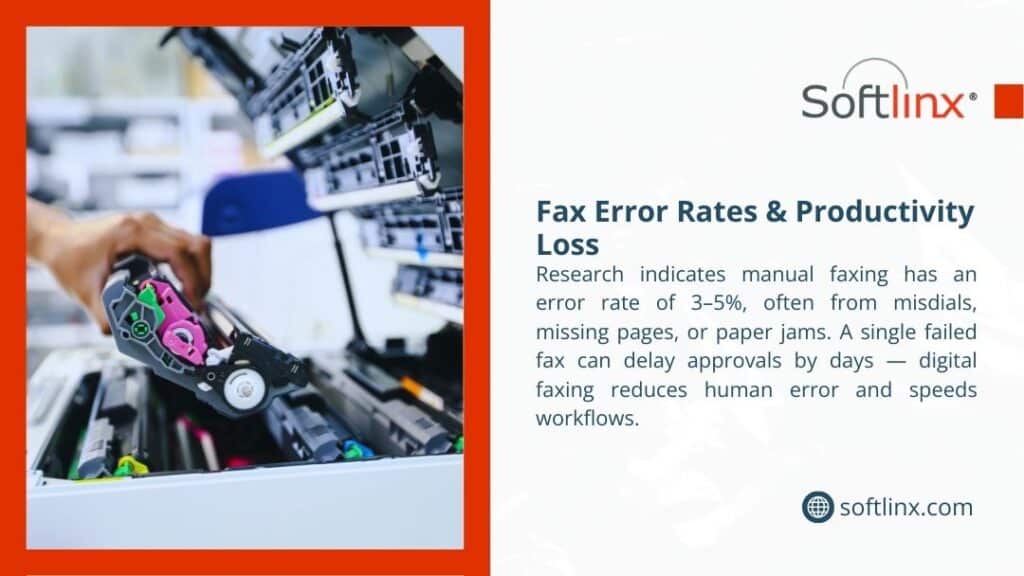
Hard cost reduction grabs attention first, yet digital fax also changes the risk profile and daily experience for staff.
Healthcare research from 2025 found that 88% of practitioners saw fax-related delays affect patient care. In many organizations, staff still chase lost pages, re-fax lab results, or wait by a machine while critical documents go through. A secure cloud fax setup that routes documents into clinical systems, revenue cycle tools, or secure inboxes cuts that friction. Faxes are sent and received within controlled workflows, not lost in a pile.
Risk also shifts. Printed faxes left on trays or stored in filing cabinets raise the odds that protected health information or financial data ends up in the wrong hands. Material that passes through a secure cloud fax platform travels over encrypted channels and lands in systems with access controls and audit trails.
That structure reduces the risk of a reportable breach and provides better proof for regulators. For US healthcare entities, HIPAA-compliant fax service reduces both exposure and the cost of evidence when questions arise.
Compliance costs extend beyond healthcare. Financial institutions face record-keeping and supervision rules. Government bodies handle confidential records where unauthorized disclosure carries legal and political consequences.
Securing fax traffic in a secure cloud fax environment that logs when faxes are sent and received provides traceability that physical fax machines simply do not match.
Short-term savings matter, but fax systems behave like infrastructure. They sit in the background for years, and small monthly deltas compound over time.
Legacy fax servers and analog lines lock organizations into peak-capacity planning. On-premises fax systems are often sized for the busiest hours and then sit underused at night or during quiet months.
Some analyses note that large organizations can see their yearly fax volumes swing from roughly half a million pages to well over a million, which means on-premises systems have to be built to handle peak demand even when day-to-day usage varies. That overbuild pushes cost up even when volume drops.
Cloud fax operates differently. Capacity scales elastically, and many providers charge by page volume or offer tiers that reflect actual usage bands, not hypothetical peaks. Analyst guidance on cloud fax solutions notes that enterprises that adopt cloud fax avoid on-premises telephony costs tied to fax lines and reduce IT overhead for fax infrastructure, which helps long-term return on investment as more workflows shift toward digital channels.
Organizations that rely on high-volume outbound fax for statements, orders, or notifications can also push more volume into automated flows when they adopt production fax automation and barcode-based fax workflow rather than manual processes. Those changes further raise the long-term gap between traditional and cloud models.
Each organization carries a unique mix of lines, hardware, and workflows, so the most precise answer to how much can you save switching to cloud fax comes from your own numbers. A practical estimate starts with a simple inventory.
First, collect data on every fax number and line on your invoices. That includes individual POTS lines, analog ports on multi-function devices, and any dedicated trunks used solely for fax. Recent industry commentary highlights that many businesses still pay for dormant fax lines because no one tracks them closely, which inflates spend with no benefit. For each line, note the monthly fee, any surcharges, and any long-distance or per-minute charges.
Second, list hardware tied to fax: stand-alone machines, fax-enabled copiers, and fax boards in servers. For each, estimate the share of cost and maintenance that relates directly to fax rather than printing or other functions, drawing on the hardware and service figures already discussed.
Add supplies such as toner and paper used solely for fax. This step gives you an annualized figure for traditional fax machines and multi-function devices as part of your fax system.
Third, talk with staff about the time they spend each week on fax tasks. That includes walking to devices, checking whether faxes are sent and received, re-sending after busy signals, separating inbound faxes by recipient, and filing.
Healthcare and IT surveys consistently show that manual fax work consumes significant hours and often delays downstream work. Convert those hours into a dollar figure with a reasonable average loaded rate. Even if you treat this as a softer saving, it still reflects the real capacity you could redirect.
Once you have those totals, ask what a secure cloud fax plan would cost for the same page volume and number of fax numbers. When you plug that subscription figure into your model in place of lines, fax hardware, and much of the support load, you see the annual and five-year gap between old and new.If you want that estimate with more precision and built-in workflow advice, a specialist vendor can walk through your environment. Providers that support deep workflow integration, such as enterprise cloud faxing and fax workflow automation tools, usually help customers turn rough inventories into concrete ROI models.

As organizations retire analog lines and replace aging hardware, the question of how much can you save switching to cloud fax becomes far more concrete. The pattern is clear across healthcare, finance, government, manufacturing, and education: once fax moves into a secure cloud environment, spending stabilizes, operational friction drops, and teams no longer lose time to devices, busy signals, or manual routing. Cloud fax shifts faxing from a resource-heavy legacy system into a predictable, low-risk part of everyday operations.
The real calculation depends on your own mix of fax numbers, line charges, volumes, and internal workflows. To see what that looks like in dollars, not estimates, you can request a tailored savings review from a provider experienced in regulated industries. A focused assessment turns the question of how much can you save switching to cloud fax into a clear set of numbers tied to your environment.
If you’re ready to quantify the savings and modernize your fax operations with a secure, industry-compliant platform, you can request a personalized cloud fax savings estimate through Softlinx.
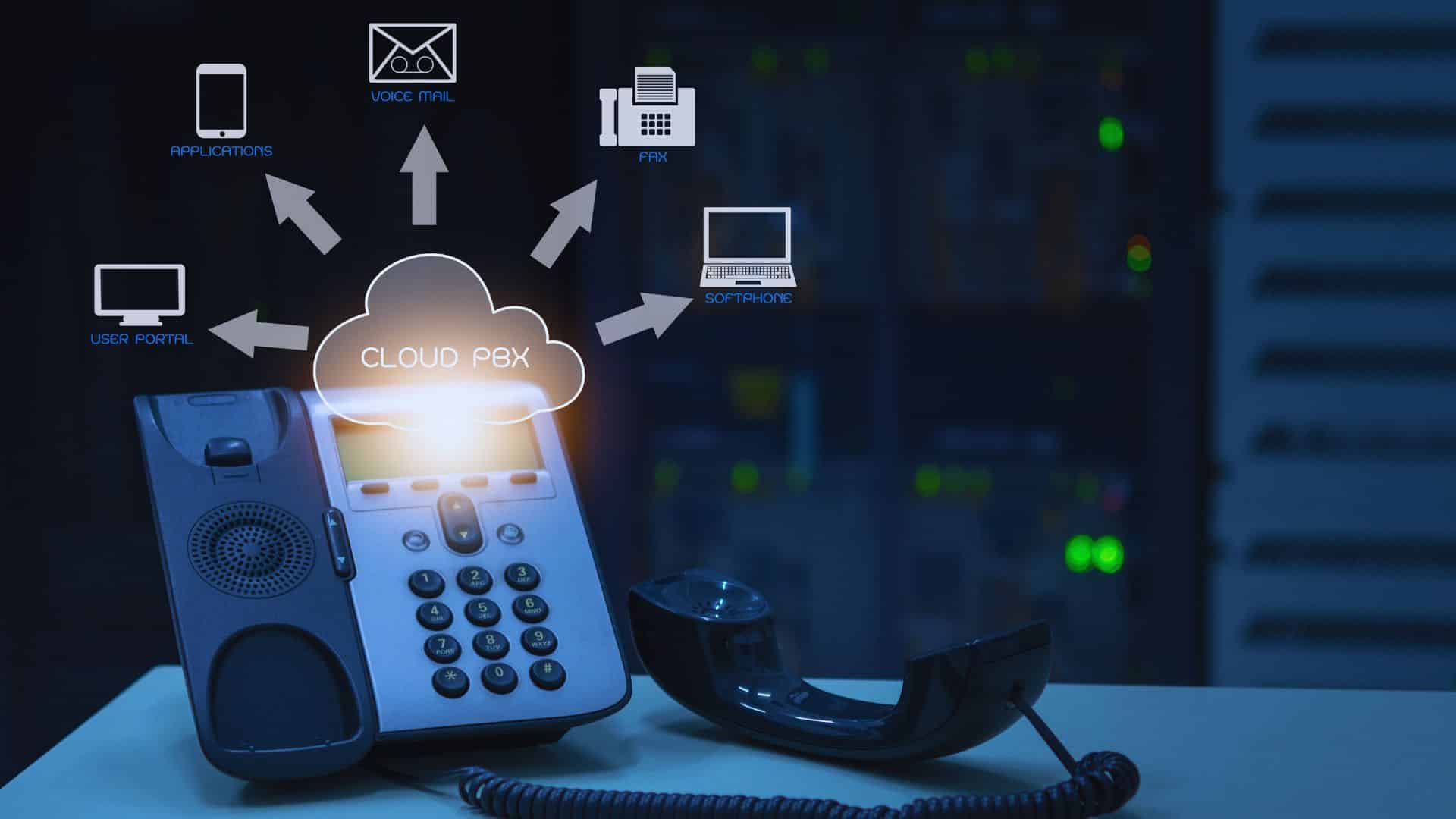
Cloud fax has become essential for U.S. organizations that handle regulated data, high-volume fax communications, or multi-location operations. This article explains how benefits of cloud fax works, why it outperforms traditional fax methods, and what advantages it brings to healthcare systems, financial institutions, insurers, government agencies, enterprises, and educational institutions.
Additionally, it also examines security, compliance, scalability, workflow integration, and advanced enterprise features that older fax systems cannot match.
Despite constant talk about “paperless offices,” fax remains a core communication tool across many American industries. Healthcare facilities depend on fax for clinical notes, orders, and records.
Insurers process claims through fax. Government agencies depend on fax for sensitive communications. Financial institutions and legal offices use fax because it ensures traceability and secure document transfer.
Cloud fax builds on these needs without the drawbacks of legacy fax equipment. Instead of a physical fax machine linked to a dedicated phone line, cloud fax uses an internet-based infrastructure to send and receive documents.
Users upload a file through a web portal, an email client, a print driver, or an API. The cloud fax provider handles delivery to the recipient’s fax number, even if that recipient uses a traditional machine.
Cloud fax eliminates physical devices, toner, paper jams, and line congestion. It also removes the need for telecom services dedicated only to fax. More importantly, cloud-based fax systems introduce digital-level transparency, audit visibility, automation, and compliance safeguards that legacy machines cannot provide.
For a detailed breakdown of cloud fax capabilities, Softlinx outlines them under its cloud fax service section, including options for healthcare faxing, enterprise faxing, and specialized production fax.
Legacy fax systems have survived for decades, but their weaknesses have become obvious, especially for U.S. organizations with remote staff or multi-site operations. The biggest limitations include hardware breakdowns, rising telecom costs, long-distance surcharges, unpredictable line congestion, and misdirected printouts.
A traditional fax machine requires a dedicated phone line. That line becomes a bottleneck when volumes spike. Faxes print on hardcopy paper unless someone scans them manually. If the device jams, overheats, or runs out of toner, business stops. Physical faxing exposes sensitive documents to anyone who walks by a machine. In regulated industries, that risk can trigger compliance violations.
Storage is another pain point. Physical fax files pile up quickly, and many U.S. organizations still devote closets or entire alcoves to paper archives. This is costly and inefficient.Cloud fax removes all of these problems. No physical hardware. No paper output trays. No line issues. Documents routed digitally. Incoming faxes arrive in email inboxes or secure portals. Outgoing faxes leave through email-to-fax, print-to-fax, or a web portal.

The following are the core benefits of cloud fax for businesses.
Security has become the top concern for U.S. organizations, especially those in healthcare, finance, insurance, and government. Cloud fax platforms secure documents end-to-end with encryption during transmission and storage. Access to fax files requires authenticated login credentials, cutting the risk of unauthorized access.
Unlike a physical fax machine that prints documents openly, cloud fax keeps all files in secure digital form. Audit trails show who accessed each file and when. This is essential for HIPAA compliance, which requires strict control over patient information. Softlinx provides thorough guidance on this topic through its HIPAA fax and HIPAA-compliant fax service pages.
According to a 2023 data-exfiltration report from the U.S. Department of Health and Human Services, 79% of large healthcare breaches reported in 2022 were caused by hacking or other IT incidents, while only 5% involved paper or film records such as printed charts or documents. Cloud fax eliminates that risk because documents never sit on a printer tray.
Financial institutions also benefit from secure transmission. The Federal Financial Institutions Examination Council (FFIEC) highlights digital audit trails and encrypted communication as required data-protection measures. Cloud fax aligns with these requirements and reduces compliance risk.
Cloud fax simplifies cost management. The organization no longer buys fax machines, pays for repairs, or stocks toner. Dedicated phone lines disappear. Long-distance charges vanish. Cloud fax pricing follows a predictable monthly or annual structure.
While cost claims must remain general rather than promotional, it is widely documented that fax hardware maintenance accounts for a significant portion of fax-related expenses. A 2024 IDC MarketScape report confirms that digital fax infrastructure can deliver lower costs, greater reliability, better scalability, and enhanced workflow integration compared with traditional analog fax over telephone lines. Cloud fax stabilizes costs by eliminating those variables.
Enterprise teams also avoid downtime caused by broken machines or telecom issues. This matters for hospitals, financial firms, and government agencies that communicate time-sensitive information daily.
The shift to remote and hybrid work across the U.S. pushed many organizations to review their communication infrastructure. Employees needed to fax documents without visiting a physical office. Cloud fax enables staff to send and receive documents securely from any internet-connected location.
A nurse working at a satellite clinic, a claims processor working from home, or a case manager coordinating services across states can all access the same cloud fax platform. This makes cloud fax valuable for organizations with multiple campuses or large geographic footprints. Softlinx addresses these use cases through its healthcare-focused pages, including hospital cloud fax solutions and clinic cloud faxing.
Cloud fax adapts to any volume. A healthcare system transmitting thousands of daily orders, a financial institution processing loan packets, or a government department distributing compliance notices can scale up instantly.
Enterprise cloud fax services support high throughput, bulk faxing, broadcast fax, and automated workflows. Production faxing is especially useful for organizations that send large batches of patient forms, claim letters, HR notices, or regulatory alerts.
For example, insurance companies often send large numbers of policy updates at once. Bulk fax eliminates the need to schedule these transmissions manually. Similarly, manufacturing plants use broadcast fax to distribute process changes across multiple locations.
Cloud fax integrates with existing systems through APIs. Instead of manually uploading every document, organizations automate fax workflows from within their EHR, CRM, ERP, or document management platform. Softlinx documents these capabilities under cloud fax APIs and broadcast faxing, and its broader developer API section.
Automation allows organizations to route incoming faxes into specific folders, workflows, or queues. Healthcare providers use barcode routing to distribute orders and results to the right clinical departments. Insurance companies automate claims routing. Government agencies distribute forms digitally without human intervention.
Traditional faxing produces a stack of paper that must be filed manually. Cloud fax stores every document digitally. Users search by date, sender, or subject. Audit logs track activity. Storage no longer requires back rooms, file cabinets, or off-site archiving. Recovery becomes simple, since every document remains stored in an encrypted cloud space.
Organizations that rely on legacy fax machines struggle with unpredictable logs, busy signals, and long-distance failures. Cloud fax eliminates “fax uncertainty.” Web dashboards show real-time status, delivery confirmation, timestamps, and failed attempts. IT teams gain visibility into usage trends and volumes, which helps with planning and compliance documentation.
Hospitals and clinics often need evidence that a referral, radiology order, or authorization request was delivered. Cloud fax provides that proof instantly. Financial or legal teams benefit from the same visibility.
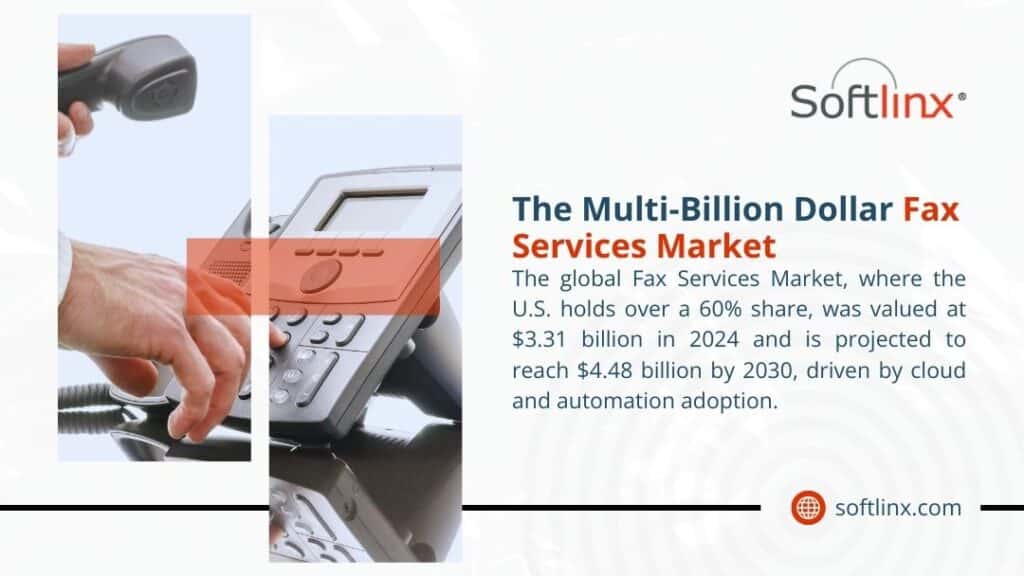
Some industries rely on fax more than others. Healthcare, insurance, banking, government, manufacturing, and education face strict requirements for data protection.
Clinical workflows still depend heavily on fax. Cloud fax allows providers to manage referrals, test results, lab orders, discharge summaries, authorizations, and insurance communications securely and efficiently. Softlinx offers detailed guidance through healthcare faxing solutions and its EHR integration pages, including EPIC integration and EHR integration.
Insurers manage claims, forms, policy updates, and medical necessity reviews. Financial firms transmit sensitive loan packets or customer records. Both sectors require encryption and audit logs. Softlinx addresses these industries through financial services, faxing, and insurance faxing.
Government departments exchange secure documents with citizens, businesses, and internal stakeholders. Fax remains widely used for regulatory compliance, recordkeeping, and secure communication. Cloud fax improves transparency and offers secure audit trails that traditional fax machines lack.
Manufacturing firms use fax for supply chain coordination, order confirmations, and regulatory documentation. Colleges and universities rely on fax for records processing, admissions documents, and departmental communications.
| Feature | Description | Who Benefits Most |
| Bulk and Broadcast Fax Capability | Allows organizations to transmit large volumes of documents in one action, supporting high-volume outreach and operational communication. | Insurance companies distributing notices, manufacturers sharing updated SOPs, and healthcare networks issuing policy changes across multiple clinics. |
| Barcode-Based Fax Workflow | Uses barcode identifiers to route incoming fax documents to correct destinations automatically, improving accuracy and speed in document distribution. | Hospitals, outpatient clinics, billing departments, and administrative teams handling high-volume clinical or claims documentation. |
| Fax Server Replacement | Replaces aging on-site fax servers with a secure cloud-based system, eliminating hardware maintenance and telecom dependencies. | IT departments, enterprise organizations are retiring legacy fax servers, and teams are consolidating communication infrastructure. |
| Automated Digital Queues | Incoming faxes enter pre-assigned digital folders or workflow queues based on pre-set rules such as sender or document type. | Healthcare operations, insurance processing teams, government agencies, and any organization receiving high volumes of inbound faxes require fast sorting. |
Organizations evaluating cloud fax options benefit from focusing on measurable, verifiable criteria rather than broad claims. The priority is proven compliance support, especially for sectors that handle protected or regulated information.
A reliable provider must offer encrypted transmission and secure storage to protect documents in transit and at rest. High availability and strong service reliability also matter, since downtime interrupts essential communication flows and creates operational risk.
A thorough audit trail is another important factor because it provides transparency for security teams and compliance auditors. For enterprise-level operations, true scalability is essential; the system must handle fluctuating or high-volume fax activity without congestion or performance delays.
Integration flexibility should also be a central requirement. Effective cloud fax platforms connect smoothly with existing systems through APIs, EHR platforms, CRM tools, ERP systems, and other workflow environments.
Customer support remains a deciding factor for many organizations, particularly those migrating away from legacy fax servers or coordinating multi-site transitions. Lastly, a provider should maintain clear, well-defined data retention and storage policies so organizations understand where information resides, how long it remains accessible, and how it will be handled throughout the document lifecycle.
Some organizations hesitate due to familiarity with legacy fax machines or concern about internet outages. Modern cloud fax providers use redundant infrastructure, secure architecture, and well-documented workflows that minimize downtime and ensure continuity. Staff training also tends to be straightforward because email-to-fax and web portal workflows mirror familiar processes.
Concerns about privacy or phishing diminish with secure authentication, encryption, and audit logging. For healthcare organizations, the availability of HIPAA-compliant fax safeguards gives leadership confidence in cloud adoption.
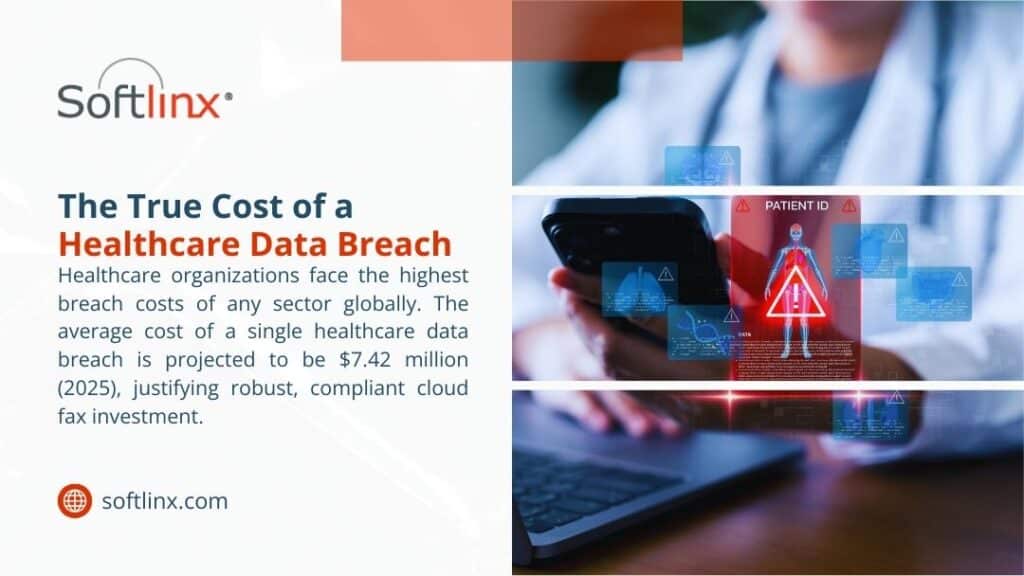
The benefits of cloud fax reflect the realities of modern business operations in the United States. Organizations need secure, compliant, scalable communication tools that work across multiple locations and support both remote and onsite staff. Cloud fax offers improved security, audit trails, workflow automation, predictable expenses, and scalability that traditional fax machines cannot match.
For industries that depend on fax as part of daily workflows, healthcare, finance, insurance, government, education, and manufacturing, cloud fax is no longer optional. It has become an essential component of secure and efficient communication. Organizations ready to upgrade can review the cloud fax options described across Softlinx’s ecosystem, including healthcare faxing, enterprise faxing, and workflow automation. A modern system provides the reliability and compliance safeguards that U.S. businesses need to operate efficiently in a digital-first environment.
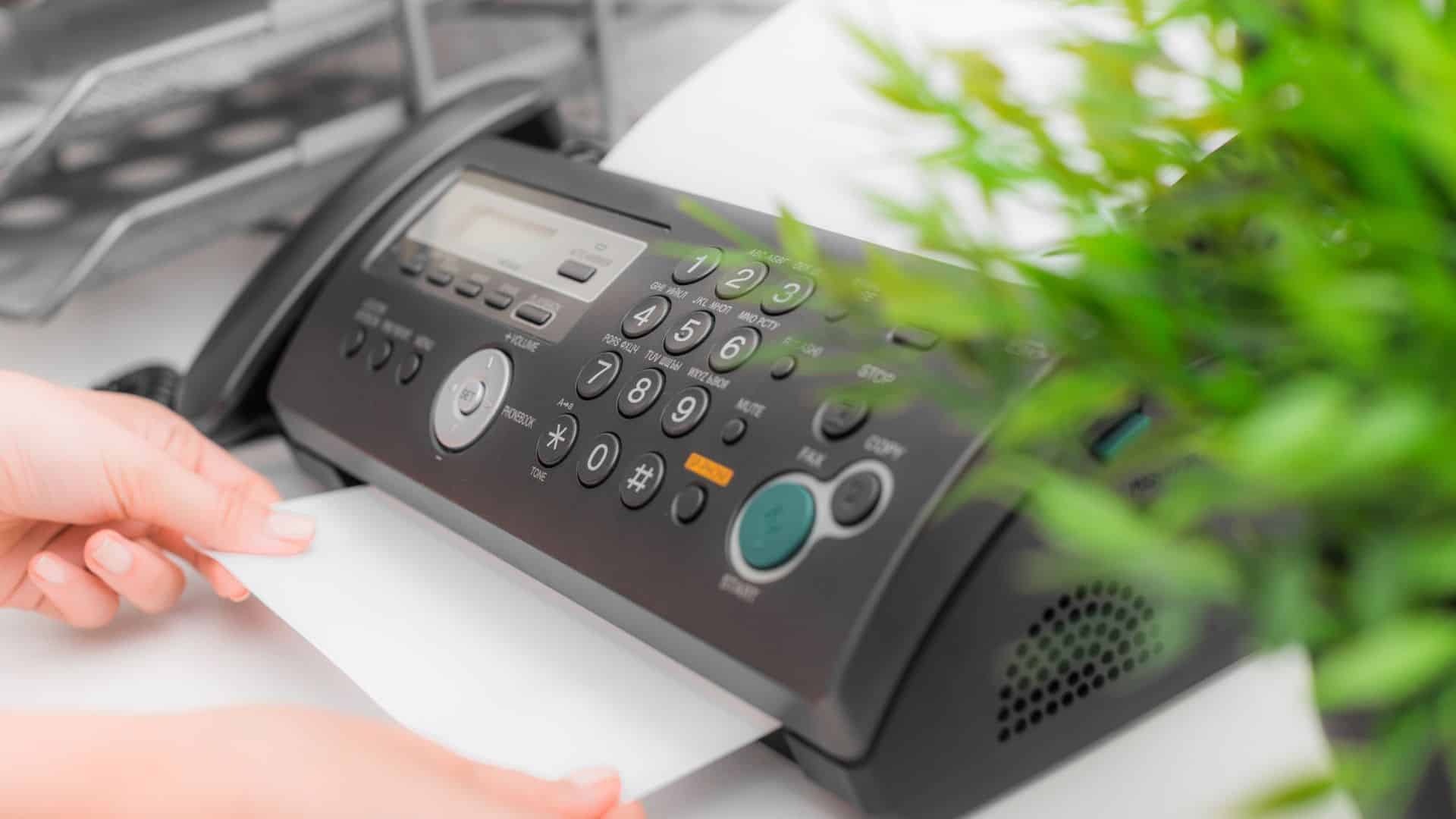
Do Enterprise Fax Solutions Offer Reliable Uptime for High-Volume Needs? This article explains how enterprise fax platforms maintain the level of uptime required by healthcare networks, financial institutions, insurers, and government agencies that process thousands of documents per hour.
It covers the architectural requirements behind consistent availability, the difference between legacy servers and modern enterprise cloud fax, and the role of virtual channels, redundant carrier paths, and secure data centers in stabilizing high-volume fax traffic.
Additionally, the article also examines how reliable uptime supports clinical workflows, EHR data movement, claims routing, prior authorization, financial approvals, and regulated document exchanges.
Readers will see why modern cloud fax systems routinely reach SLA commitments of 99.95% availability and how platforms such as Softlinx sustain that performance during peak demand periods without hardware congestion or line saturation.
Large organizations conduct essential communication through fax. Hospitals send and receive faxes for referrals, lab results, authorizations, and discharge documents across systems that integrate with EHR workflows supported by platforms such as HIPAA fax.
Financial institutions depend on fax for confidential forms, signatures, and regulatory communication. Insurance carriers move high-volume documentation across internal and external parties. These workflows depend on uninterrupted transport, which makes uptime a foundational part of any enterprise fax solution.
Enterprise cloud fax systems anchor reliability on secure routing, carrier-grade SIP networks, and multiple gateway paths. This eliminates the bottlenecks found in physical fax machines and on-prem fax servers.
When questions arise, such as do enterprise fax solutions offer reliable uptime for high-volume needs, the answer centers on whether the platform uses scalable virtual channels, redundant telephony paths, and continuous monitoring to prevent congestion or downtime.
Traditional technology often restricts throughput. Legacy servers depend on analog trunks that cap capacity, while fax machines slow high-volume workflow cycles and introduce manual work.
Large organizations with variable daily volume often face busy signals, delays, and hardware issues. In contrast, enterprise cloud fax systems operate inside highly redundant environments engineered to support constant availability.
The best way to assess reliability is to evaluate the architecture behind enterprise cloud fax. Platforms built for high-volume traffic rely on virtual fax channels that expand capacity without requiring additional hardware.
Telephony gateways maintain multiple redundant paths for outbound and inbound calls, allowing traffic to shift automatically if one route experiences congestion.
To make the comparison clear, the table below contrasts core components of modern cloud fax with traditional fax servers found in older environments.
| Component | Enterprise Cloud Fax | Traditional Fax Servers |
| Capacity Handling | Virtual channels scale instantly | Fixed physical lines limit volume |
| Routing Behavior | Dynamic failover maintains uptime | Single-path routing increases downtime risk |
| System Maintenance | No internal hardware or phone lines | IT teams manage boards, trunks, and updates |
| Throughput | Supports large daily volume without congestion | Bottlenecks appear in peak hours |
| Security Standards | Hosted in audited U.S. data centers | Local security varies widely |
| Interruption Points | Minimal failure points | Hardware, trunks, and machines can fail |
Organizations that routinely process thousands of daily faxes across clinical, financial, and operational systems benefit from this type of scalable architecture. Continuous monitoring detects irregularities, while automated recovery paths preserve uptime without intervention.
This allows high-volume teams to move away from the limits of older systems, such as on-prem fax servers, now replaced by cloud alternatives outlined in resources like the fax server guide.
Softlinx supports this model through secure cloud fax services that remove the dependency on internal servers and analog lines. The platform routes fax traffic across redundant systems tested against healthcare-level requirements. Facilities such as hospitals, clinics, surgery centers, and outpatient practices benefit from consistent uptime through specialized solutions, including hospital cloud fax solutions and other clinical service options.
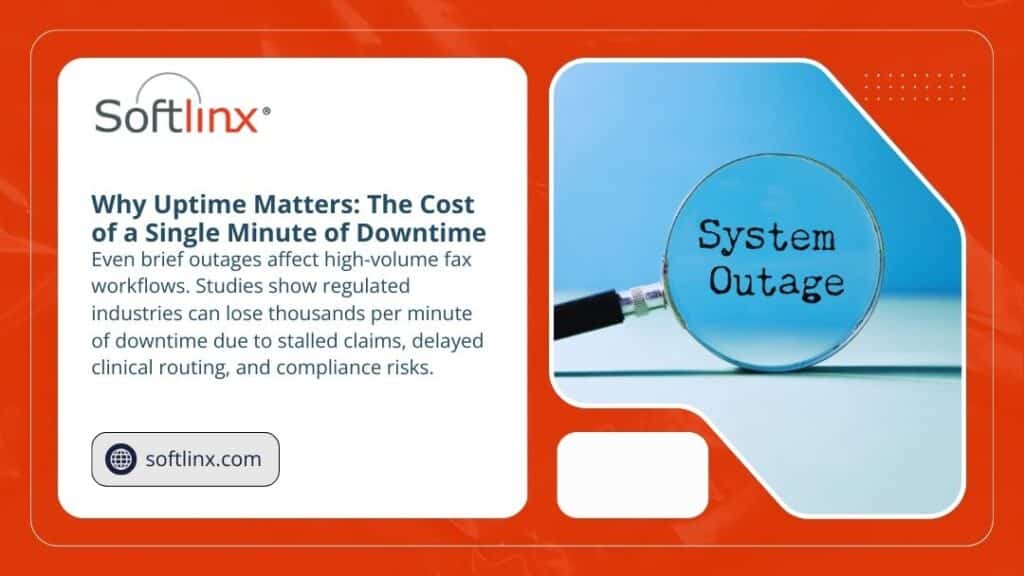
Enterprise fax performance carries direct consequences for patient records, claims handling, financial document movement, and regulated workflows. For this reason, healthcare organizations adopt enterprise cloud fax at a rapid pace, replacing traditional faxing with secure and scalable platforms.
The question of do enterprise fax solutions offer reliable uptime for high-volume needs becomes even more relevant in environments where fax volume peaks during emergencies, seasonal surges, and cross-department communication cycles.
Healthcare organizations often work with sensitive data protected by HIPAA requirements, which have strict expectations for secure fax transport. Platforms built for HIPAA-related workflows highlight secure routing, encryption, audit trails, and continuous availability.
Several groups use specialized services based on facility type, such as clinic cloud fax solutions, and many prefer cloud models over on-site systems due to their reliability under pressure.
Regulated industries outside healthcare share similar expectations. Enterprise cloud fax supports secure document routing for financial services, insurance underwriting, government agencies, and multinational institutions where large-scale faxing remains part of compliance and audit requirements. These organizations need assurance that uptime remains steady during peak periods, when thousands of documents must move without interruption.
High-volume workflows benefit from automation features that reduce manual intervention. Automated routing places incoming documents into specific network folders, EHR modules, or departmental queues.
Barcode-based processing scans incoming pages for identifiers that categorize documents without human review, which reduces bottlenecks and speeds downstream tasks.
When organizations automate fax steps, the stability of the underlying system carries greater weight. Automated systems depend on continuous availability, accurate routing, and proper document recognition.
Softlinx’s routing capabilities support traffic allocation across secure endpoints and provide consistent performance through its enterprise cloud fax platform. Healthcare and operational workflows integrate with systems such as EHR and practice-management platforms through resources like EHR integration.
Automation strengthens uptime because it decreases manual retry cycles, reduces user-related delays, and eliminates the disruptions created by congested local hardware. The more automated the process, the more uptime matters, because even small outages affect entire document chains.
On-prem fax servers rely on physical trunks and analog pathways. These infrastructures can fail due to power issues, network interruptions, or equipment breakdowns. Physical machines also remain vulnerable to hardware faults, paper jams, or toner shortages. When organizations attempt to scale, they face rising costs and maintenance requirements.
Enterprise cloud fax systems remove these constraints. Documents travel through monitored, redundant telephony channels and encrypted paths secured inside U.S. data centers. Cloud environments operate with multiple layers of protection, including intrusion detection, auditing, and continuous health checks. This structure provides a more stable foundation, especially for facilities with diverse endpoints such as dental clinics, veterinary offices, or rehabilitation centers supported by services like rehabilitation center cloud fax solutions.
Softlinx supports secure cloud fax capabilities that allow healthcare facilities, financial institutions, government departments, and large enterprise groups to use a single platform for high-volume faxing without managing hardware or telephony.
The platform supports document transport through encrypted channels, making it suitable for HIPAA-related environments that depend on a HIPAA-compliant fax service.
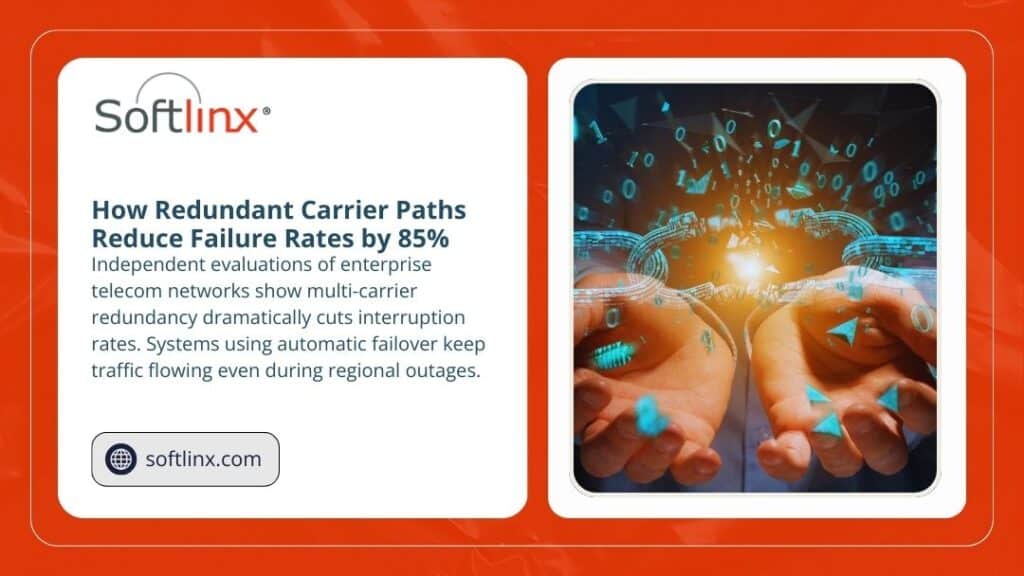
Organizations often evaluate performance metrics before selecting an enterprise cloud fax solution. They review availability targets, telephony redundancy, failover paths, data center certifications, and integration support. These elements shape overall reliability and determine whether the platform can maintain constant throughput.
The table below outlines the main factors that influence uptime in enterprise settings.
| Factor | Impact on High-Volume Workflows |
| Telephony Redundancy | Multiple carrier paths prevent interruptions. |
| Virtual Channel Capacity | Supports simultaneous high-volume traffic. |
| Data Center Standards | HIPAA, SOC 2, and audited infrastructure ensure secure uptime. |
| Workflow Routing | Automated routing reduces manual errors and retry cycles. |
| Integration Support | Direct EHR, financial, and government integration reduces delays. |
| Monitoring Systems | Continuous monitoring detects and corrects issues early. |
Softlinx supports large organizations with routing options across healthcare, insurance, and government channels. These include specialized workflows for teams that need secure cloud-based routing without the congestion common in older systems.
For example, many practices adopt specialized services for chiropractic, dermatology, orthopedic, or cardiology groups, supported by offerings such as cardiology practice cloud fax solutions.
When evaluating enterprise cloud fax platforms, organizations look for stable availability, scalable architecture, and strong compliance infrastructure. High-volume environments depend on continuous uptime due to the number of documents transmitted across departments each hour. Softlinx supports these needs through secure routing, reliable SIP gateways, and automated workflows capable of supporting thousands of daily transactions.
Teams that continue to use older systems often explore cloud alternatives by reviewing guidance such as fax through the internet, or by comparing performance against VoIP-based systems, including the overview at VoIP fax.
Many also shift from traditional email-based workflows into structured fax transport using references like How to email to a fax number. These transitions usually occur when high-volume requirements begin to strain legacy fax environments.
To support rapid operational needs, organizations that depend on specialized routing and automated processing often adopt enterprise cloud fax solutions designed for scalability. Softlinx provides an established framework for these scenarios and supports cloud fax routing, encrypted transport, and compliant document handling across large networks.
For teams evaluating options, the main question remains: do enterprise fax solutions offer reliable uptime for high-volume needs? Platforms with the right infrastructure, routing logic, and security posture consistently meet this standard.An evaluation of Softlinx cloud fax services can be found at cloud fax, where organizations can review architecture details, secure routing, and compliance support required for enterprise-level fax operations.
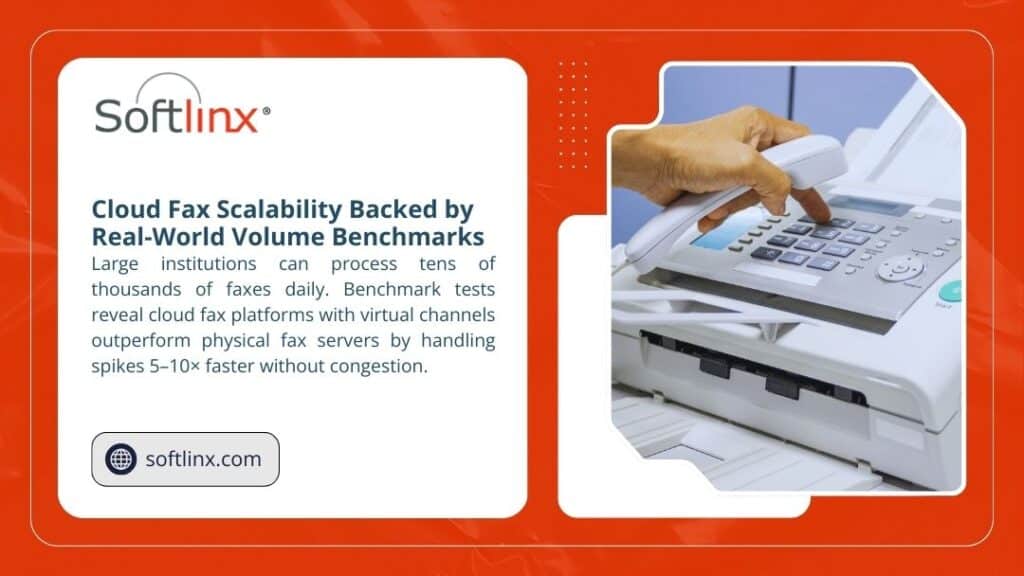
Enterprise fax solutions built on cloud architecture routinely meet high-volume demands by using redundant carrier paths, scalable virtual channels, and protected routing environments. These systems outperform legacy fax servers by reducing interruptions, lowering congestion, and removing the hardware limitations that create downtime.
Organizations that depend on consistent throughput, whether clinical, financial, or operational, gain stability from platforms designed to deliver continuous availability.
Enterprises evaluating their next step can review Softlinx’s broader capabilities through its dedicated cloud fax platform at Softlinx.
For teams that want to adopt a secure, scalable, and high-availability fax environment, the most direct path is to request a tailored solution through Softlinx cloud fax services.
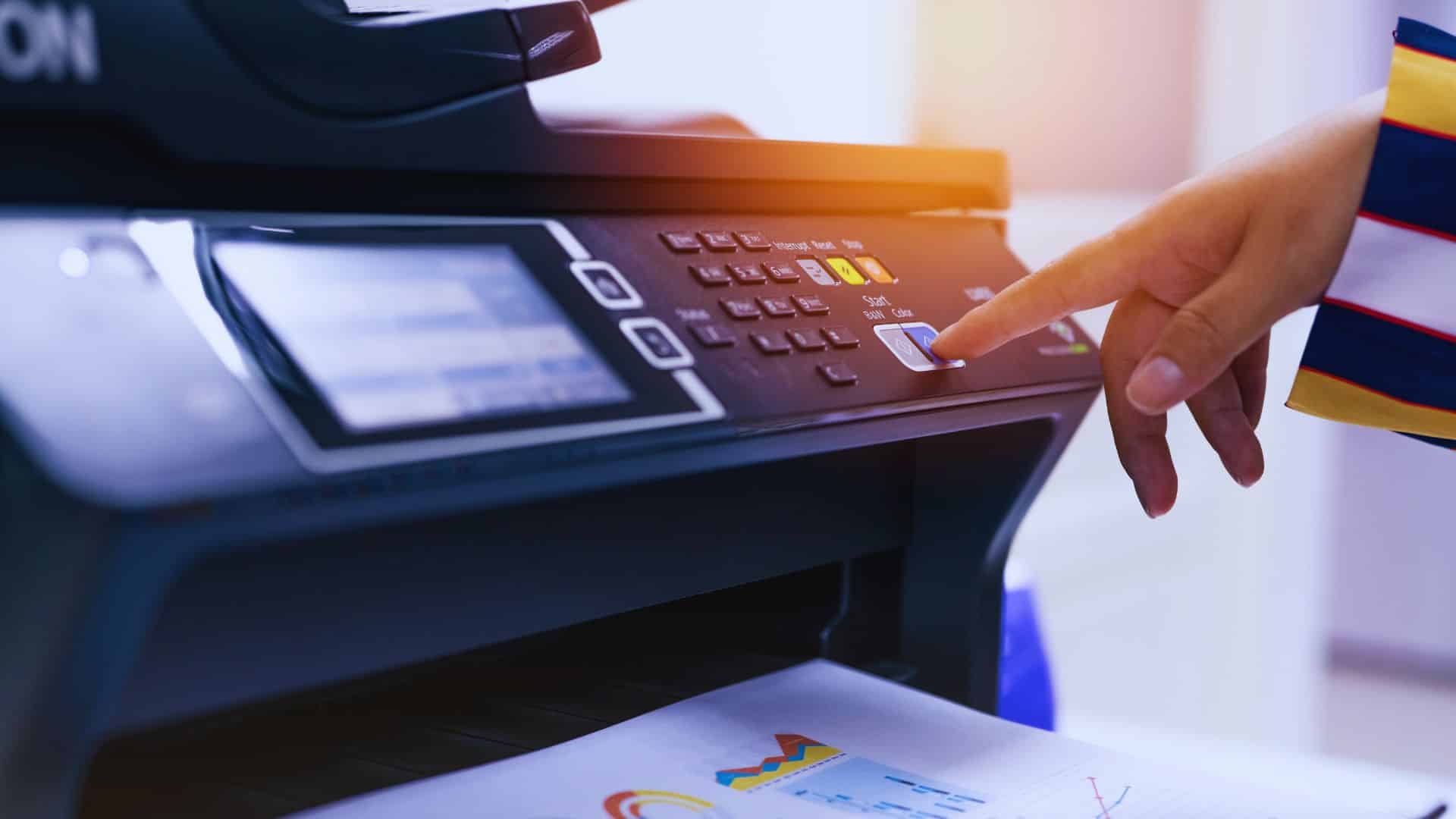
This guide explains how automating incoming fax routing strengthens security, supports regulated environments, and removes repetitive manual tasks that slow down daily operations.
You will see how automated routing moves faxed documents into compliant systems, why routing logic boosts accuracy, how cloud fax workflows help healthcare and enterprise organizations reach consistent performance, and what benefits emerge when manual sorting, paper handling, and unreliable fax machines disappear.
A detailed breakdown of routing components, workflow behavior, and real industry examples helps readers understand how automated routing reshapes document management across clinical, administrative, and operational units.
Automating incoming fax routing forms the backbone of modern fax communications across healthcare, insurance, financial, and government environments. These sectors rely on a secure fax solution that can send and receive faxes without exposing sensitive information or forcing staff to manage printed documents.
Automated routing directs incoming faxed documents straight into protected workflows, which avoids the risk tied to manual error and reduces the time and resources previously spent on sorting or rescanning pages.
Many organizations run outdated fax machines or legacy fax servers. Those systems create slowdowns, especially during high-volume periods. When teams migrate toward digital routing or replace their on-prem hardware with a more stable option like the Softlinx model described on the fax server, the move produces immediate operational relief.
Routing steps no longer depend on physical devices or analog phone lines, and staff no longer search for missing pages.
Manual routing slows clinical and administrative teams, especially when fax machines, shared inboxes, or outdated hardware sit at the center of daily workflows. Printed pages pile up, files go to the wrong department, and sensitive documents risk exposure. These delays increase during peak hours or when staff step away from the device, creating gaps that automated routing eliminates immediately.
Institutions that handle sensitive information must maintain consistent and secure fax communications. Automating incoming fax routing reduces the risk of misplaced or exposed records because the routing engine places each document in a controlled, encrypted environment.
A cloud-delivered route also prevents the common failures that occur with analog lines. Regulated organizations often shift toward transport over a secure internet connection, and many readers gain clarity on this transition through the explanation provided in the guide on faxing through the internet.
The strengthened protection that automated routing provides helps organizations meet strict privacy requirements. Every routed file moves through encrypted storage and verified access pathways, giving compliance officers clear documentation for audits. This also helps maintain consistent retention schedules and supports complete traceability across long-term records.
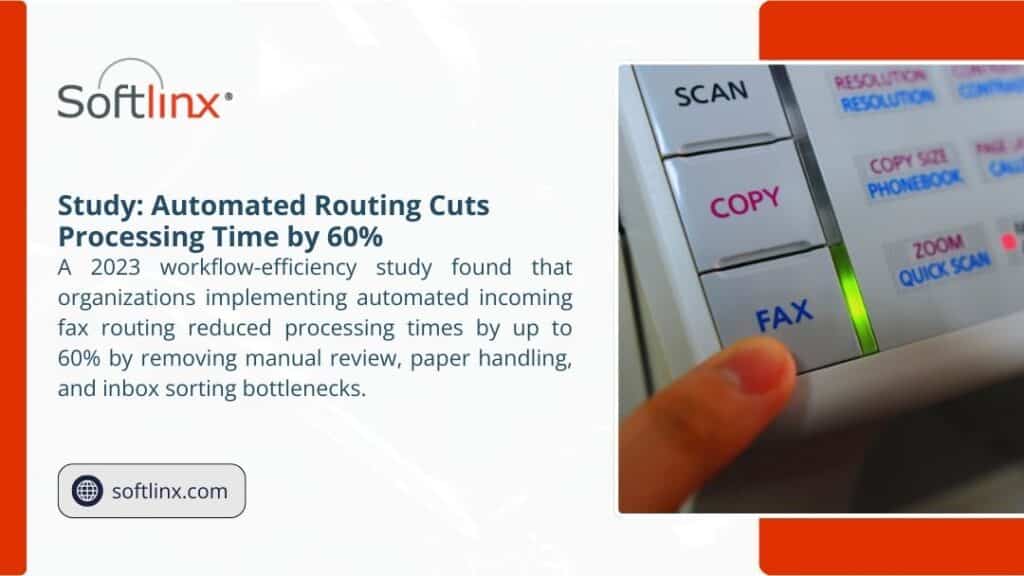
The following table explains the key parts of an automated incoming fax routing system and how they influence daily operations.
| Component | Function | Business Impact |
| Routing Engine | Reads sender data, barcodes, and routing rules | Sends incoming faxes to the correct destination without manual effort |
| Secure Storage Layer | Holds documents in encrypted, access-limited repositories | Protects sensitive information from unauthorized access |
| Application Connectors | Moves documents into EHRs, ERPs, or document management platforms | Removes duplicate steps and supports high-volume work environments |
| Notification System | Alerts responsible teams when new documents arrive | Prevents delays and eliminates repeated inbox checks |
| Audit Trail | Logs delivery events, routing decisions, and access activity | Strengthens compliance reporting across regulated industries |
This framework allows automated routing to deliver consistent accuracy every day. For organizations that must send and receive faxes inside an EHR environment, the deeper integration model highlights how routing aligns with clinical workflows.
Healthcare organizations face the most intense fax loads. Hundreds or thousands of referrals, lab reports, authorizations, and treatment notes arrive daily. Without automated routing, these documents require manual review and sorting, which slows patient care and increases the risk of misplacement.
Automated routing directs each received fax to the correct clinical or administrative team, and this routing logic aligns naturally with the broader hospital-level approach offered through Softlinx’s hospital cloud fax solutions.
Specialty clinics also benefit greatly. A dermatology practice receives pathology reports and consultation notes throughout the day, and the routing structure outlined in the dermatology clinic cloud fax solutions resource places those documents directly into secure queues without placing extra pressure on front-office staff.
Cardiology groups handle imaging results, EKG interpretations, and discharge updates, and a workflow similar to the one at cardiology practice cloud fax solutions moves those files into the correct review folders as soon as they arrive.
Orthopedic providers manage pre-operative clearances, surgical summaries, and diagnostic reports, and the structured distribution method shown at Orthopedic Clinic Cloud Fax Solutions supports those cases through structured distribution and secure storage.
Chiropractic offices also manage large volumes of incoming faxed documents, such as treatment plans or physician notes. The workflow design available at chiropractic office cloud fax solutions demonstrates how automating incoming fax routing prevents delays and removes unnecessary manual review.
Every healthcare setting, from specialty practices to outpatient centers, must maintain strict safeguards, and the privacy standards explained in Softlinx’s HIPAA-compliant fax requirements reinforce how automated routing protects sensitive information throughout all incoming fax communications.
Accuracy increases when routing rules assign each inbound fax to a specific destination without leaving room for human interpretation. Regulated organizations depend on precise document placement, full audit visibility, and controlled file access. Automated routing supports these requirements through rule-based classification, encrypted storage, and defined access pathways that prevent misfiled records or untracked document movement.
Automated routing transforms document management by eliminating messy manual sorting. Instead of printing incoming faxes or scanning pages into shared email inboxes, the routing engine directs each record to the correct folder, application module, or workflow queue.
This becomes especially valuable in environments where received faxes influence patient care, supply chain coordination, billing accuracy, or administrative decision-making. Centralized routing also supports distributed teams and remote staff, who gain instant access to incoming files without relying on a physical fax machine. As the volume of fax communications grows, structured routing ensures every received fax moves through a predictable, compliant path.
Organizations that rely on fax heavily often combine automated routing with purpose-specific workflows.
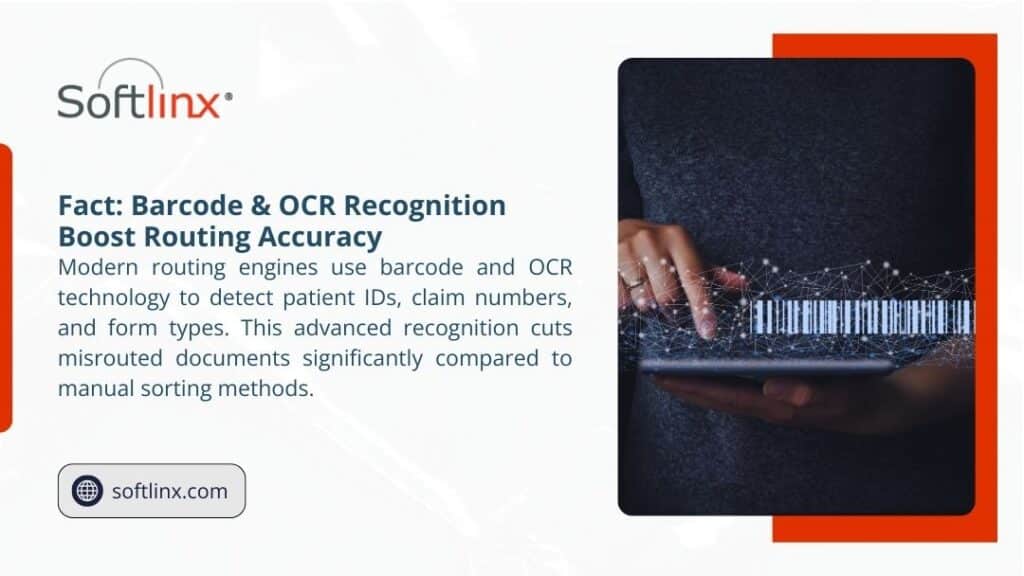
Legacy fax machines create delays through jams, missing pages, long print queues, and limited storage capacity. On-premise fax servers often require intensive IT support and rely on outdated telephony hardware.
Automating incoming fax routing avoids these issues because routing happens in a secure, digital environment rather than through analog lines. Organizations that want to modernize their transmission path often apply secure VoIP-based faxing.
When routing happens automatically, teams do not wait for printed pages or struggle with unreliable equipment. Instead, documents appear instantly in the systems where staff already work. This helps organizations maintain consistent performance during peak demand periods.
Many incoming documents contain protected health information or other confidential records. Automating incoming fax routing protects these documents by limiting human contact, maintaining encrypted storage, and applying strict access controls.
This approach aligns with HIPAA expectations across administrative, physical, and technical safeguards. For teams reviewing HIPAA questions, the compliance guidance in Softlinx’s overview of HIPAA fax requirements offers additional clarity.
Routing also enhances audit accuracy. Every step is recorded, from transmission to routing to retrieval. Compliance teams can confirm access history, routing behavior, and file locations through the audit trail, simplifying both internal checks and external reviews.
| Area | Manual Routing | Automated Routing |
| Delivery Method | Printed pages or email attachments | Encrypted digital delivery into secure workflows |
| Speed | Slower and inconsistent | Immediate routing to assigned teams and systems |
| Data Protection | Higher exposure risk | Controlled access and encrypted storage |
| Labor Impact | Requires constant staff involvement | Removes repetitive administrative steps |
| Reliability | Prone to delays and hardware issues | Rule-driven routing with consistent output |
Organizations exploring cloud-based workflows may also find it valuable to review broader cloud fax capabilities.
Hospitals route referrals and results into clinical modules. Clinics send and receive faxes without touching a physical machine. Insurance carriers sort claims instantly through routing rules. Government agencies handle public requests through consistent document paths. Manufacturing firms process purchase orders and vendor records with less manual review.
Each industry benefits because routing reduces errors, accelerates response times, and ensures sensitive information moves through an encrypted, compliant framework. Organizations that must perform high-volume broadcast or bulk transmissions can extend routing with specialized tools.
IT teams can integrate routing directly into internal applications through APIs. This allows each incoming fax to land inside the exact folder, queue, or record field where it must be processed. Projects that require healthcare-specific integration can follow the technical walkthrough.
API-based routing eliminates all manual involvement. Developers apply rules once, and the system handles every future document consistently and securely.
Remote teams depend on stable access to incoming faxed documents. Automated routing places new documents directly inside secure web portals or connected applications, which makes location irrelevant. Hybrid organizations do not need on-site fax hardware. Instead, incoming records move through consistent routing paths that maintain full compliance visibility.
This also simplifies long-term record management. Audit logs show exactly where each file traveled, who viewed it, and when it entered the system. When retention schedules require precise documentation, automated routing provides the necessary structure.
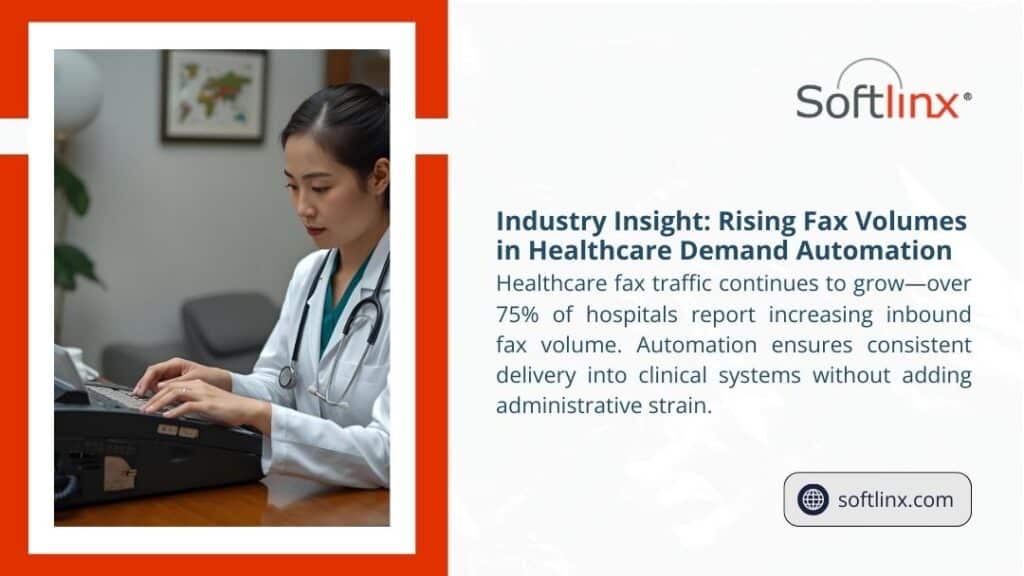
Routing rules can match incoming fax numbers to departments, specialty units, administrative teams, or file categories. A medical center, for example, can assign one number to its billing department and another to its care coordination team. Routing then delivers each document to the correct location without manual interpretation.
In larger organizations, this reduces the load on administrative teams and strengthens time-sensitive processes. Insurance and financial offices rely heavily on automated classification because each incoming fax begins a new workflow.
Government agencies benefit as well, since they must keep public records organized and accessible. Readers seeking guidance on organizing routing inside complex enterprise workflows can review the Softlinx enterprise fax routing model.
| Industry | Challenge | Automated Routing Benefit |
| Healthcare | High volume of referrals and reports | Faster routing into clinical systems and secure folders |
| Insurance | Time-sensitive claims and requests | Organized queue assignment and fewer errors |
| Financial Services | Confidential client forms | Encrypted routing with strict access controls |
| Government | Public-facing document flows | Consistent routing for departmental review |
| Manufacturing | Supply chain and vendor records | Reliable delivery into production and logistics workflows |
Automating incoming fax routing eliminates delays, prevents manual errors, and helps regulated institutions maintain consistent control over sensitive data. When incoming faxed documents reach the correct team instantly, staff can respond faster, workflows remain stable, and compliance reporting becomes easier to produce.
Automated routing replaces outdated hardware-based handling with a secure digital framework that adapts to the complex operational demands of healthcare, insurance, financial services, government, and manufacturing environments.Organizations evaluating a secure routing model can take the next step by reviewing the available solutions and discussing goals with Softlinx. Start by exploring the Softlinx solutions and consultation.
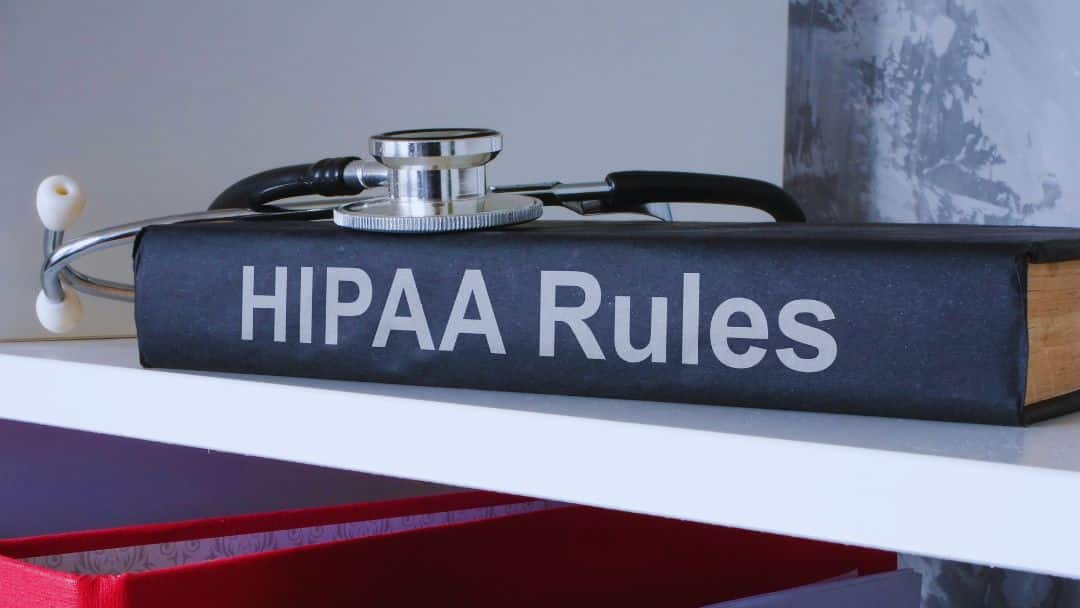
HIPAA rules for faxing medical records still apply to a majority of U.S. hospitals and clinics that rely on fax for referrals, authorizations, lab reports, and release of information requests. Three federal rules control every faxed document that contains PHI: the HIPAA Privacy Rule, the HIPAA Security Rule, and the Breach Notification Rule.
These rules decide when a provider may send patient medical records by fax, who may receive them, how they must be protected, and what happens when a fax reaches the wrong recipient.
The Privacy Rule defines lawful use and disclosure of PHI. The Security Rule requires safeguards for electronic faxes and stored images, including authentication, access limits, and, where reasonable and appropriate, encryption.
The Breach Notification Rule dictates the steps a covered entity must take when PHI reaches an unauthorized person. Fax remains legal under HIPAA, but only when HIPAA rules for faxing medical records shape every part of the workflow.
Fax-related incidents continue to appear in OCR investigations, especially when devices are unsecured or numbers are misdialed, which shows these risks are still very real.
Healthcare organizations close most of these risks through modern HIPAA-compliant cloud fax with verified fax numbers, access control, audit trails, and controlled routing into an EHR.
Softlinx builds its secure cloud fax platform around these requirements so hospitals, clinics, and specialty practices follow HIPAA rules for faxing medical records without slowing down clinical tasks.
Fax never fully left healthcare. Surveys and industry reports show that a large portion of hospitals and physician groups still depend on fax for coordination with external partners, payers, and pharmacies.
At the same time, regulators now look harder at data security and access rights than at any previous point. The HIPAA Privacy Rule still grants patients a clear right of access to medical records, while the Security Rule and new enforcement pressure focus on gaps that lead to breaches.
That context places HIPAA rules for faxing medical records in a tight spotlight:
Cloud fax and electronic health records (EHR) have not erased fax numbers from referral forms. Instead, HIPAA rules for faxing medical records push health systems toward secure cloud fax platforms that match the Privacy Rule, Security Rule, and Breach Notification Rule without forcing staff to abandon familiar fax workflows.
Yes. HIPAA allows fax transmission of PHI such as lab reports, consult notes, and discharge summaries, as long as covered entities use reasonable safeguards. The Office for Civil Rights (OCR) states that a physician may fax patient medical information to another provider for treatment purposes and may disclose PHI by fax for other standard HIPAA use cases.
The key question is not “fax or no fax,” but “do current processes match HIPAA rules for faxing medical records when those records leave your system?”
The main HIPAA rules for faxing medical records sit in three pillars:
In short, HIPAA rules for faxing medical records do not ban fax machines, but they treat any faxed document that contains PHI as part of the same regulatory framework that covers EHR entries and other digital medical records. For deeper policy detail, Softlinx already covers the high-level questions around HIPAA fax and common myths about HIPAA-compliant fax workflows.
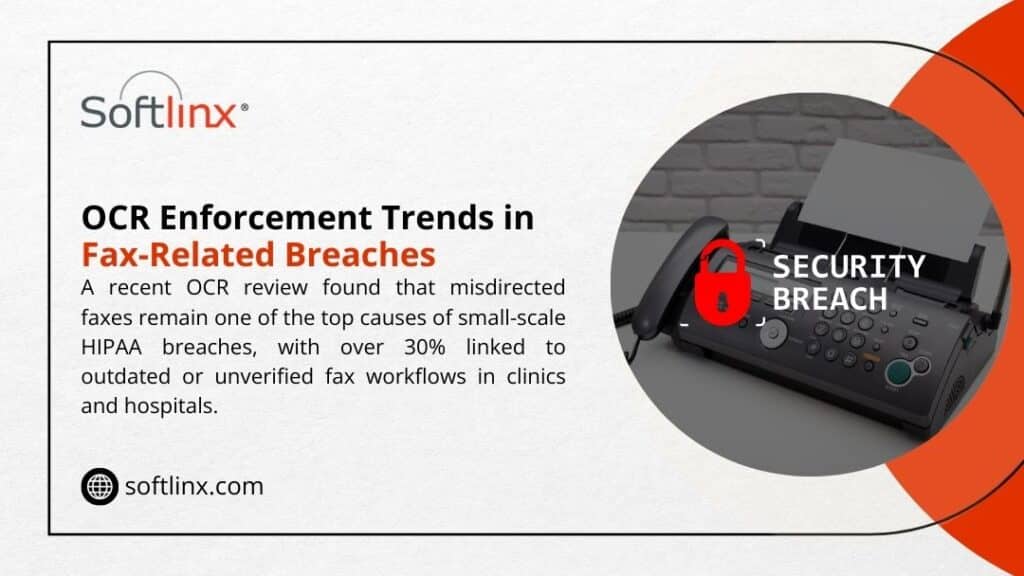
When a nurse, registrar, or medical records clerk presses “send,” several specific risks and safeguards come into play. OCR expects covered entities to prevent unauthorized access in ways that match the size and complexity of each organization.
The table below condenses how HIPAA rules for faxing medical records map to concrete actions.
| Risk area | What HIPAA expects | Example of better practice with secure fax |
| Wrong fax number | Reasonable steps to verify recipient identity and contact details before disclosure of PHI. | Staff confirm the fax number in the EHR or scheduling system, then select it from a verified list inside a HIPAA-compliant fax solution instead of dialing digits on a physical fax machine keypad. |
| Unnecessary PHI on the fax | Minimum necessary use and disclosure under the Privacy Rule. | HIPAA rules for faxing medical records favor concise packets: only the pages that relate to the clinical question or claim review, not the entire designated record set. |
| PHI seen in a public area | Physical safeguards under the Security Rule, plus Privacy Rule expectations around incidental disclosure. | Fax delivery moves to a secure cloud fax portal with user logins, rather than a hallway fax tray. If a multi-function device still receives paper, it sits in a restricted office, not a lobby. |
| Weak access control for electronic faxes | Technical safeguards such as unique user IDs, role-based access, and access logging. | Electronic faxes sit inside a cloud fax service that ties into single sign-on, logs every view and download, and limits PHI access to staff whose roles fit that patient’s care or billing work. |
| No fax cover sheet or weak warnings | Reasonable safeguards, plus OCR guidance on limiting disclosure to intended recipients. | Every fax that carries PHI uses a fax cover sheet template with a strong confidentiality notice, sender and recipient details, and a request to destroy misdirected faxes. |
| No audit trail | Documentation requirements for HIPAA compliance and breach investigation. | The fax system keeps a durable log: date, time, fax number, user ID, and delivery status for each faxed document. In a cloud fax portal, staff can export this log during an audit. |
These safeguards sit at the heart of HIPAA rules for faxing medical records. They protect protected health information (PHI) at each stage: creation, transmission, receipt, storage, and disposal.
Providers that still rely on analog devices can reach part of that standard, but secure cloud fax platforms give far stronger control over PHI in healthcare while still allowing staff to send faxes with a familiar workflow.
If your team still depends on legacy telephony, Softlinx explains how modern fax through the internet resolves many of those exposure points without ripping out every existing process.
AI overviews and PAA boxes tend to spotlight a simple version of this question. The short answer: HIPAA rules for faxing medical records expect a mix of policy, training, and technical safeguards that cover both paper faxes and electronic faxes.
Cloud fax services that Softlinx describes as HIPAA-compliant fax wrap these safeguards into a managed platform. That framework reduces the chance that one missed step by front-line staff turns a simple fax into a HIPAA violation.
Compliance risk shifts slightly from one setting to another, but HIPAA rules for faxing medical records set the same core obligations for every covered entity. The table below illustrates how common care environments face specific fax risks and how targeted cloud fax solutions help.
| Care setting | Typical fax use | Key HIPAA risk | Cloud fax angle |
| Acute-care hospital | Discharge summaries, transfer packets, referrals, and payer authorizations. | High fax volume makes it easy for patient information to reach the wrong floor or external number. | A hospital cloud fax solution routes inbound faxes directly into the EHR or secure folders and ties each faxed document to the right medical record number. |
| Community clinic | Specialty referrals, charity care documents, and release of medical records. | Shared devices and small spaces make paper faxes visible to visitors. | A clinic cloud fax solution replaces paper trays with inboxes inside a secure web portal that staff reach with unique logins. |
| Urgent care center | Work notes, test results, referrals to primary care. | Fast pace tempts staff to shortcut verification of fax numbers. | An urgent care cloud fax solution lets staff pick recipients from verified directories instead of keying in full fax numbers at speed. |
| Dental and specialty practices | Treatment notes, pre-authorizations, images, or reports. | Many practices sit outside hospital IT and may not have mature HIPAA safeguards for fax devices. | A dental office cloud fax solution or other specialty package adds HIPAA compliance without the cost of a full in-house infrastructure. |
Softlinx publishes separate guidance for hospital, clinic, and other specialty cloud fax solutions, which helps each practice map HIPAA rules for faxing medical records to its own scale and workflow mix.
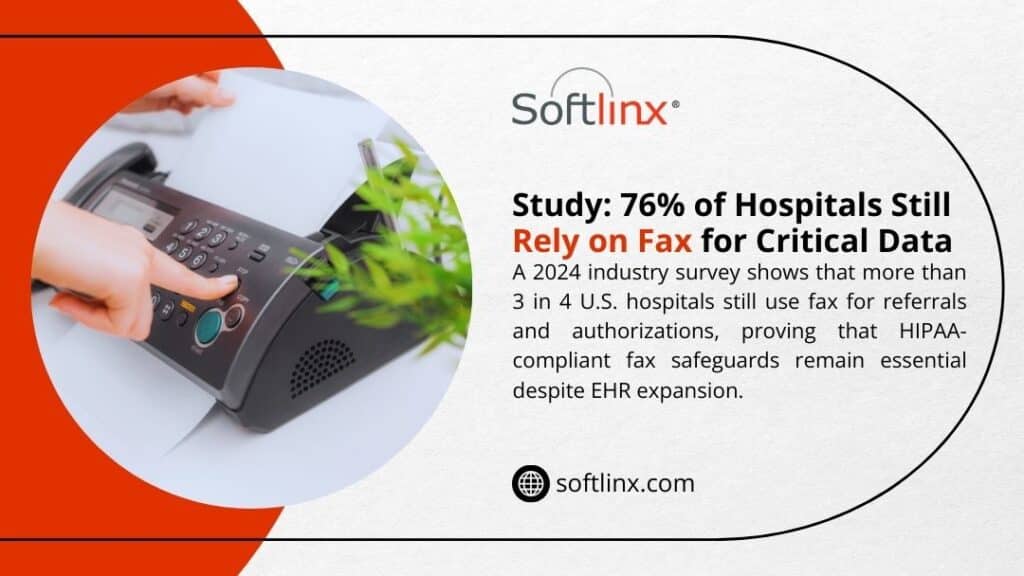
HIPAA does more than restrict disclosure; it also gives patients a clear set of rights. The Privacy Rule grants patients the right to access, inspect, and receive a copy of medical records from covered entities, with only limited exceptions and with time limits that appear in 45 CFR 164.524.
Fax still plays a role in those rights:
| Patient-centered issue | Relevance of HIPAA rules for faxing medical records |
| Right of access | Many patients ask, “How can I get my medical records fast?” HIPAA allows providers to send copies by fax if the patient requests that method and accepts related risks. Staff must confirm the fax number, document the request, and send only the PHI the patient has requested. |
| “Who can access my medical records without my permission?” | HIPAA laws permit certain disclosures without explicit authorization, such as treatment, payment, health care operations, and specific public health or law-enforcement scenarios. The same rules apply when PHI travels by fax, so any such fax requires the same minimum necessary standard and safeguards. |
| Release of information to third parties | An attorney’s request on HIPAA rules for faxing medical records, an employer’s request, or a life-insurance request usually needs a signed HIPAA authorization or HIPAA medical release form. Fax remains a common channel here, but the presence of that HIPAA release form does not excuse poor security practices. |
| Access to digital medical records | Many systems route faxed documents into an electronic health record, where they become part of the designated record set. Patients then exercise HIPAA rights through patient portals and other digital means. |
Because faxed medical records often end up as scanned images inside the EHR, teams need strong integration between their fax solution and the core clinical systems. Softlinx outlines EHR integration patterns that tie cloud fax directly into registration, coding, and clinical workflows so that each faxed document lands in the right chart instead of a shared inbox.
Traditional fax devices rely on analog phone lines with no encryption. That weakness turns every outbound fax that carries PHI into a potential exposure point. Modern HIPAA rules for faxing medical records favor digital options that deliver better data security:
| Approach | Security profile | Role in a modern HIPAA compliance plan |
| Legacy fax machine on an analog line | No encryption, paper output, weak logging, and are often placed in public areas. | Suitable only as a stopgap, with strict physical safeguards, low PHI volume, and tight manual controls. |
| VoIP fax on the general phone system | Moves traffic to IP networks but can still lack full end-to-end encryption and audit trails. | Better than analog, but still often below the standard that a full HIPAA-compliant fax platform aims to provide. |
| Cloud fax integrated with EHR | Encryption in transit and at rest, strong authentication, role-based access, detailed audit logs, and direct links into the EHR and practice management system. | Often, the most practical route to meet HIPAA compliance requirements while staff to continue to send faxes through familiar workflows. |
Softlinx describes how fax through the internet, VoIP fax, and cloud fax differ in practice and how a cloud platform can still respect existing PSTN or SIP routes where needed. The company’s material on bulk fax APIs, electronic fax workflow automation, and API setup for healthcare applications shows how health systems can keep HIPAA rules for faxing medical records front and center while still modernizing infrastructure and reducing manual work.
Softlinx also explains in plain terms how to email a fax number inside a HIPAA-compliant framework, which can help physicians and care managers who live in their email client but still need fax for external partners.
| Key point | Why it matters |
| HIPAA permits faxing of PHI | HIPAA rules for faxing medical records do not forbid faxing; they require clear safeguards across Privacy, Security, and Breach Notification Rules. |
| Safeguards must match risk | OCR expects covered entities to apply reasonable administrative, physical, and technical safeguards; small clinics and large health systems both face scrutiny. |
| Patient rights still apply | Right of access, HIPAA patients’ rights, and release of information processes do not stop at the fax machine; they extend to every faxed document that contains PHI. |
| Cloud fax closes many gaps | A mature HIPAA-compliant fax service with EHR integration, audit logs, and encryption eases compliance pressure and helps prevent unauthorized access. |
| Policy plus technology wins | Written HIPAA fax rules, staff training, and modern cloud fax platforms together reduce the odds of a breach under HIPAA and simplify audits. |
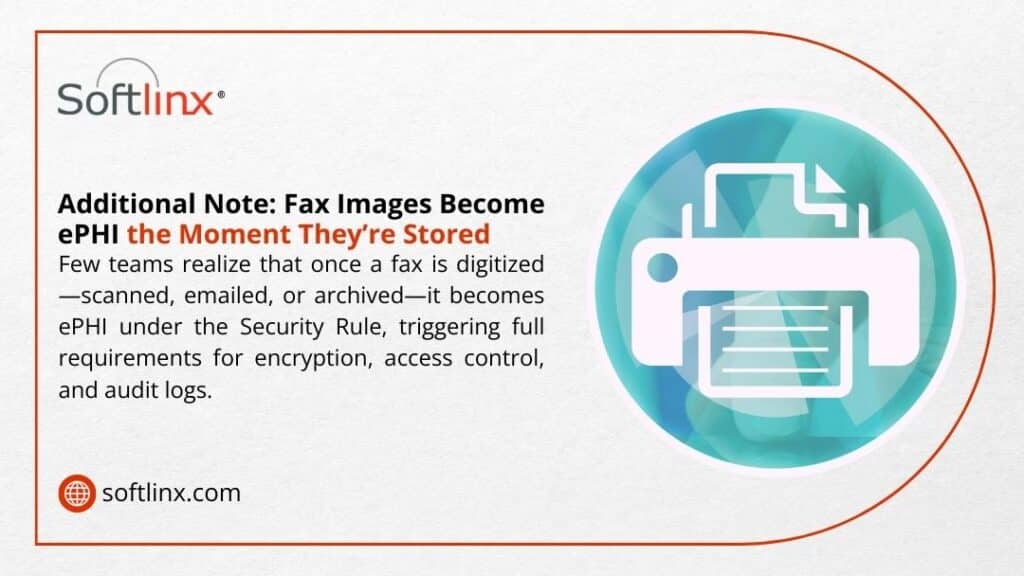
HIPAA rules for faxing medical records touch almost every corner of a health system: front-desk registration, clinical teams, HIM, revenue cycle, and legal. Every fax that carries patient medical records reflects your stance on HIPAA compliance, HIPAA privacy, and HIPAA security in a single transmission.
If your current process still leans on stand-alone fax machines, shared trays, or ad-hoc email attachments, now is the time to map each workflow against HIPAA regulations and your own risk appetite.
A structured review that pairs written policy with secure technology cuts down on HIPAA violations, protects PHI in healthcare, and answers the recurring question “what information can be shared without violating HIPAA?” with clear, defensible rules.
Softlinx designs HIPAA-compliant cloud fax for hospitals, clinics, health systems, and enterprise partners that want stronger data security without extra friction for staff. If you want a practical path from legacy fax machines to a secure, auditable cloud fax platform that matches HIPAA rules for faxing medical records, explore the Softlinx healthcare cloud fax service and then request a quote for your environment:
Move from fax risk to fax control today with Softlinx. Visit the healthcare fax service and start a tailored discussion through Softlinx.
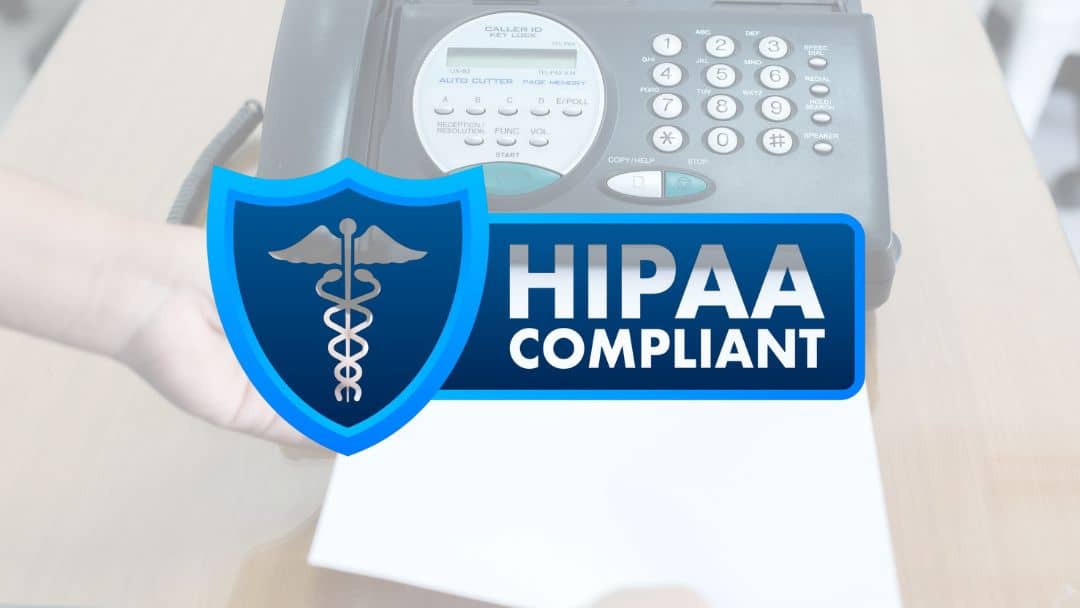
This article outlines the equipment requirements for implementing a HIPAA-compliant electronic fax service in healthcare settings. Healthcare providers often question whether transitioning from traditional fax machines requires significant infrastructure investments or specialized hardware.
The answer is straightforward: modern cloud-based fax solutions eliminate the need for dedicated fax machines, phone lines, or on-premise servers. Healthcare facilities can securely transmit patient information through existing devices, including computers, smartphones, tablets, and multifunction printers, while maintaining full compliance with the Health Insurance Portability and Accountability Act (HIPAA).
This guide examines the technical requirements, compliance standards, and practical implementation steps for electronic fax systems in medical practices, hospitals, and clinics.
The short answer is no. Healthcare organizations do not need special equipment to use a HIPAA compliant electronic fax service. Unlike traditional fax machines that require dedicated phone lines, fax servers, and physical hardware, modern electronic fax solutions operate through the internet on devices already present in most healthcare facilities.
A HIPAA compliant fax service works with standard computers, smartphones, tablets, and existing multifunction printers. The transition from legacy fax infrastructure to cloud-based fax systems eliminates hardware dependencies while strengthening security protocols for patient data transmission.
Healthcare providers can send and receive faxes through web portals, email clients, or direct integration with electronic health record systems. This approach removes the physical limitations of traditional fax machines and creates a more flexible document workflow that adapts to clinical operations.
Most healthcare organizations possess all the necessary equipment to deploy electronic fax services immediately. The infrastructure requirements are minimal because cloud-based fax platforms leverage existing technology rather than demanding new investments.
| Device Type | Current Use in Healthcare | Electronic Fax Capability |
| Desktop Computers | Administrative tasks, EHR access, and billing | Web portal fax access, email-to-fax transmission |
| Laptops | Mobile clinical documentation, remote work | Full fax functionality from any location |
| Smartphones | Clinical communication, on-call duties | Mobile app access for urgent fax transmission |
| Tablets | Bedside documentation, patient rounds | Touch-optimized fax interfaces for quick access |
| Multifunction Printers | Document scanning, printing, and copying | Direct fax transmission from the device panel |
Standard office equipment becomes part of the fax infrastructure without modifications. A clinic administrator can transmit referral documents from their desktop computer through a web browser. Physicians can receive lab results as faxes directly in their email inbox.
Nurses can scan discharge paperwork on the department’s multifunction printer and route it to specialists through the printer’s interface.
The cloud fax approach transforms existing technology into secure transmission channels without requiring specialized fax hardware. Healthcare facilities avoid the capital expenditure associated with purchasing dedicated fax servers or maintaining analog phone lines for fax machines.
HIPAA does not forbid fax. The HIPAA Privacy Rule allows a physician or healthcare organization to fax patient medical information to another provider for treatment, payment, or healthcare operations, as long as appropriate safeguards protect that information. The focus sits on the protection of patient data, not on a specific fax machine or device.
Key principles that shape any HIPAA compliant fax solution:
| Principle | What it means in practice |
| Device-neutral regulation | HIPAA does not declare one specific fax machine or fax app “approved”. It requires safeguards around any system that sends or receives patient information. |
| Safeguards over technology labels | Administrative, technical, and physical safeguards apply whether you use a traditional fax machine or a HIPAA compliant online fax service. |
| Vendor relationships | Covered entities must sign BAAs with any vendor that handles ePHI, including providers of HIPAA compliant fax services. |
| Documentation and oversight | Policies, procedures, and audit trails must show how your organization controls access to secure faxes and received faxes. |
In other words, Do I need special equipment to use a HIPAA compliant electronic fax service for healthcare? is less critical than the question of whether your faxing solution satisfies HIPAA requirements for encryption, access controls, audit logs, and BAAs.
A simple desktop fax machine with open paper trays can break HIPAA rules even though it looks familiar. A HIPAA compliant digital fax service that runs in the cloud, with audit trails and access controls, can meet HIPAA fax compliance without a single analog fax line on-site.
Softlinx describes these expectations in detail in its dedicated resource on HIPAA compliant fax requirements and how a HIPAA compliant fax service protects patient data inside healthcare workflows.
A HIPAA compliant fax service does not require specialized proprietary hardware in your facility. The table below sets out the usual components and whether they count as “special equipment”.
| Component | Typical reality in a healthcare setting | Special equipment required? | Why it matters for HIPAA compliant electronic fax |
| Workstations | Existing PCs or laptops for clinical and administrative staff | No | Staff send and receive electronic faxes through a secure web portal, EHR screen, or email client. |
| Network and internet | Existing secure LAN and internet connection | No extra hardware in most cases | The HIPAA compliant online fax platform runs in the cloud; your network only needs stable, secure access. |
| Physical fax machine | Legacy desktop unit in a corner office or nurses’ station | Not required | A modern HIPAA compliant digital fax service replaces the traditional fax machine; staff can still print when necessary, without relying on physical paper trays for PHI storage. |
| Fax server | Legacy on-prem fax server racks with fax boards and telephony connections | Not required with cloud fax | A HIPAA compliant cloud fax service removes the need for an in-house fax server and its telephony hardware. |
| Multi-function printers (MFPs) | Shared printers and scanners in departments | Optional | MFPs can still print received faxes or scan documents into workflows but no longer carry full responsibility for HIPAA fax compliance. |
| Telephony hardware | Fax boards, gateways, analog or PRI lines | Not required on your side with true cloud fax | The provider maintains secure fax telephony in the data center; your team connects through HTTPS and secure APIs. |
If you still run an internal fax system, Softlinx also explains legacy fax server setups and shows how to move away from on-prem fax hardware without disrupting clinical workflows.

Healthcare still depends heavily on fax. Various industry sources have estimated that around seven out of ten healthcare organizations use fax in core information exchange, including referrals, prior authorizations, and diagnostic reporting.
That cuts across hospitals, outpatient clinics, and multi-specialty centers. Each type of organization asks the same core question in its own way: Do I need special equipment to use a HIPAA compliant electronic fax service for healthcare in my environment?
Large hospitals often maintain older fax server infrastructure with multiple phone lines and complex routing rules. A HIPAA compliant electronic fax service for healthcare replaces that hardware with secure cloud fax queues, role-based access for clinical and revenue cycle teams, and integration with EHR or document management systems.
For hospital teams, the “equipment” question turns into an integration question. Most hospitals already have an identity system, a security perimeter, and standard endpoints that can support a HIPAA compliant cloud fax service. No new proprietary boxes are usually required. Softlinx provides dedicated hospital cloud fax solutions that plug into existing clinical systems instead of forcing a new device layer.
Smaller clinics often depend on one physical fax machine at the front desk, with inbound pages stacked in the open. That layout puts patient data at risk and can delay referrals or authorizations when staff step away.
A HIPAA compliant online fax service gives these clinics secure portal access from existing computers and tablets. The only new elements are user accounts in a secure fax application and basic staff training on password hygiene and folder use.
No new fax device is required. Softlinx tailors clinic cloud fax solutions so clinics can retire old fax machines while keeping familiar workflows for referrals, insurance forms, and lab results.
Multi-specialty centers and large medical groups face volume as their main challenge. HIPAA compliant fax services that run in the cloud handle thousands of pages per day without on-site fax servers. Document traffic routes through encrypted channels to folders, MFPs, or EHR queues that staff already monitor.
Softlinx provides medical center cloud fax solutions for these environments, with encryption at rest, transport security, and full audit trails for every fax event.
Across all three settings, one conclusion stays consistent: Do I need special equipment to use a HIPAA compliant electronic fax service for healthcare has a stable answer. A proper HIPAA compliant fax service sits in the cloud, respects your existing hardware footprint, and focuses on security, workflow, and compliance rather than more devices.
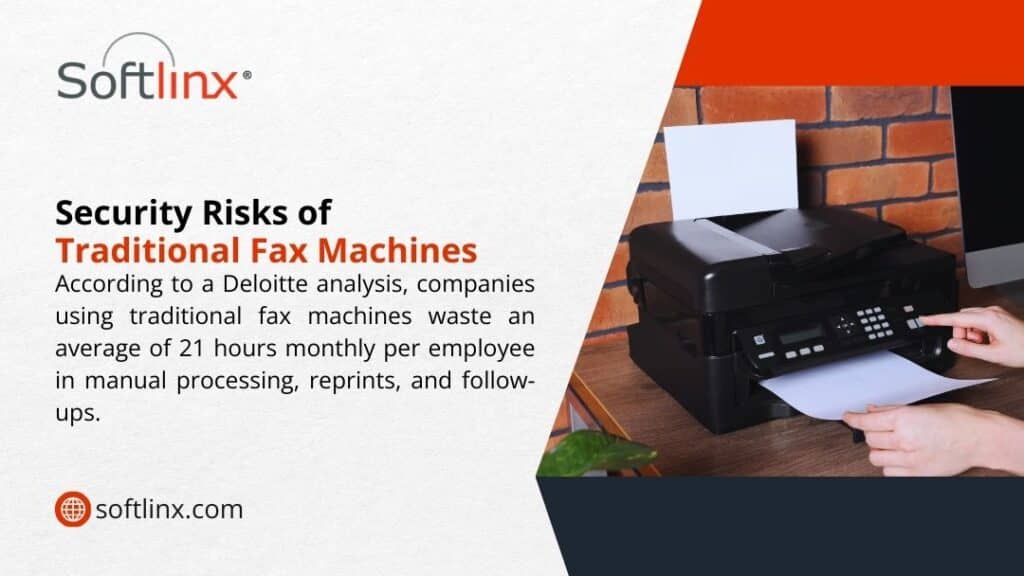
The greatest risk in healthcare fax rarely comes from the model number on the device. It comes from gaps in responsibilities and weak process control. HIPAA expects clear lines between the covered entity and the vendor. For a HIPAA compliant fax service, that split often looks like the table below.
| Area | What the cloud fax provider covers | What your healthcare organization covers |
| Core fax system | Secure fax telephony, virtual fax channels, delivery confirmation, and capacity management | Decision to retire or keep local fax machines during transition, and how those devices are used day to day |
| Security controls | Encryption at rest and in transit, firewall rules, intrusion detection, secure data center | Endpoint security on workstations, secure Wi-Fi, VPN policies, and patching on internal systems |
| Access controls | Role-based access within the fax application, secure login mechanisms, and session management | User account lifecycle, least-privilege policies, staff off-boarding, internal approvals for access changes |
| Audit trails | Detailed logs of sent, received, and deleted faxes, as well as view and download history | Review of logs, internal monitoring procedures, investigation, and documentation when something looks wrong |
| Compliance posture | HIPAA compliant cloud fax status, SOC audits, documented technical controls, and BAA terms | Risk analysis, HIPAA training, written policies for fax use, and internal compliance oversight |
| Integration | APIs, Epic and EHR integration kits, secure routing options to folders and applications | Choice of workflows, mapping of processes to integration paths, testing, and validation before go-live |
HIPAA guidance also expects covered entities to sign BAAs with third-party services that handle ePHI, including providers of HIPAA compliant fax services. Softlinx works as a HIPAA compliant fax service provider and offers BAAs that define each side’s duties.
For organizations that want to double-check the regulatory angle, Softlinx maintains a separate resource that responds directly to a frequent question: Is fax HIPAA compliant when you modernize your fax infrastructure and move to the cloud?
Softlinx focuses on HIPAA compliant cloud fax service for healthcare, finance, insurance, and other regulated sectors. The ReplixFax platform runs as a cloud-based faxing solution that removes the burden of local fax hardware and supports strict HIPAA fax compliance.
ReplixFax resides in a HIPAA-compliant, SOC-audited data center. Fax images and related metadata stay encrypted at rest, and all communication between your environment and the service uses secure transport protocols. These controls protect patient information without forcing you to install new fax boards or gateways inside your own network.
Access to this HIPAA compliant fax service runs through web applications, EHR integrations, and secure tools such as email-to-fax and print-to-fax drivers. Multi-factor authentication and role-based access govern who can send and receive faxes, who can view archived documents, and who can export data. This focus on access controls and audit trails addresses core HIPAA requirements and removes the need to lock down physical machines in every department.
For organizations that rely on Epic or other major EHR platforms, Softlinx offers specific integration paths so that staff can send and receive faxes directly inside the EHR. This approach lets healthcare teams treat fax as part of their normal clinical workflow rather than a separate, hardware-bound process.
Softlinx describes this approach in its cloud fax overview, where the emphasis sits on secure transmission over IP networks, reduced dependence on legacy phone lines, and a central HIPAA compliant fax solution instead of scattered devices.
For teams that want to see how this looks in practice, Softlinx also explains how to fax through the internet while keeping the security requirements of healthcare organizations intact and without adding new on-premise fax infrastructure.
So when a stakeholder asks, again, Do I need special equipment to use a hipaa compliant electronic fax service for healthcare with Softlinx?, the answer stays consistent: the heavy infrastructure runs inside Softlinx; your staff uses secured endpoints and applications that already exist in your environment.
Once hardware moves off-site, the strongest value of a HIPAA compliant electronic fax service for healthcare appears in automation and integration rather than in the fax transport itself. Healthcare organizations still depend on fax for referrals, prior authorizations, lab results, claims, and discharge summaries; delays in these flows can affect patient care and revenue.
Surveys in the health IT space have reported that a high share of organizations, sometimes above 80% in specific samples, have seen fax-related delays influence patient care or financial outcomes.
A HIPAA compliant cloud fax service with automation routes inbound faxes to the right department, provider, or work queue. Fax numbers can tie to service lines, clinics, or individual clinicians, which reduces misrouted documents. Document classification and barcodes shorten manual indexing time, and integration with EHR or document management systems reduces repetitive data entry.
Softlinx examines these scenarios in detail in its guide on how to automate electronic fax workflow for business and healthcare operations, with real examples of routing rules, queue design, and alerting.
On the clinical side, Softlinx offers EHR integration paths so staff can send and receive secure faxes directly within the patient record. This model keeps clinicians in one system, lowers error rates, and makes HIPAA compliant faxing part of the documented care process rather than a disconnected step at a physical fax device. Softlinx’s dedicated HIPAA compliant fax service shows how hospitals, clinics, and medical practices use the platform to move lab results, orders, and authorizations securely, again without on-site fax servers.
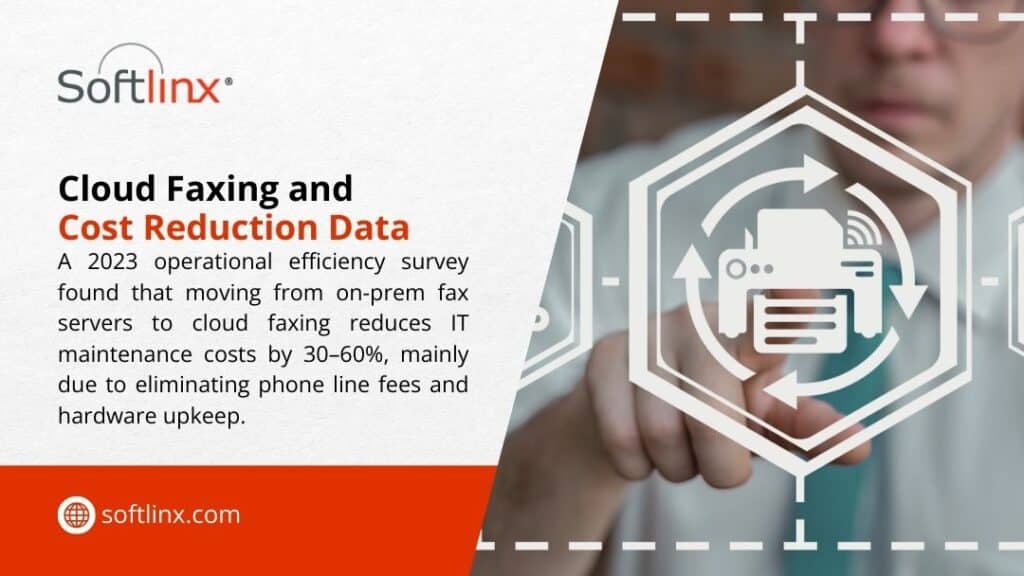
| Key point | Why it matters |
| HIPAA allows faxing with safeguards | Fax remains acceptable under the Privacy Rule as long as reasonable safeguards protect patient information before, during, and after transmission. |
| Focus on safeguards, not hardware | A traditional fax machine with open trays can break HIPAA rules; a HIPAA compliant online fax service with encryption and access controls can satisfy them without special equipment. |
| Cloud fax shifts infrastructure off-site | A HIPAA compliant cloud fax service runs telephony, storage, and encryption in the provider’s data center, which removes the need for local fax servers. |
| Existing endpoints are usually enough | Most hospitals, clinics, and medical centers already own the workstations and secure networks needed for HIPAA compliant faxing. No unique device is required. |
| Responsibilities must be defined | BAAs, policies, and audit reviews matter more than hardware purchases. Clear responsibilities between the provider and vendor support HIPAA compliance. |
| Integration improves patient care and efficiency | When fax flows inside EHR and workflow tools, staff spend less time chasing paper and more time on clinical work, while still meeting HIPAA compliance. |
Softlinx’s healthcare cloud fax service brings these pieces together for hospitals, clinics, diagnostic centers, and other providers that still rely on fax to move patient data. It concentrates on HIPAA compliant fax solutions that use standard equipment on your side and advanced controls in the cloud.
Healthcare still depends on fax for a large share of clinical and administrative communication, even with widespread EHR adoption and secure portals. As a result, your choice of fax strategy has a direct effect on HIPAA compliance, staff workload, and the reliability of information exchange between providers, payers, and partners.
Sticking with traditional fax hardware locks your organization into analog phone lines, on-site maintenance, and a security model built around doors and paper trays. A breach or misdirected document in that world can be difficult to trace and costly to fix.
A shift to a HIPAA compliant electronic fax service for healthcare changes the landscape. Fax becomes a controlled application service, with encryption, access controls, detailed audit trails, and documented BAAs that describe how patient information is protected.
Softlinx’s HIPAA compliant cloud fax service reduces dependence on physical fax machines and in-house fax servers, protects patient data with encryption and structured security controls, and connects to EHR and business applications so staff can send and receive secure faxes where they already work.
That path answers the question Do I need special equipment to use a hipaa compliant electronic fax service for healthcare? With a practical no, while also improving how your organization handles HIPAA fax compliance daily.
If your team wants to move away from fragile hardware, improve HIPAA fax compliance, and align fax workflows with modern healthcare IT, this is the right time to review your fax landscape. You can explore Softlinx’s broader secure cloud fax portfolio or speak with the team about a deployment that matches your environment and regulatory needs.
To discuss a HIPAA compliant electronic fax service for healthcare that fits your hospital, clinic, or medical group, start here: Request a secure healthcare fax assessment and quote from Softlinx.